Advertiser Disclosure
Many of the credit card offers that appear on this site are from credit card companies from which we receive financial compensation. This compensation may impact how and where products appear on this site (including, for example, the order in which they appear). However, the credit card information that we publish has been written and evaluated by experts who know these products inside out. We only recommend products we either use ourselves or endorse. This site does not include all credit card companies or all available credit card offers that are on the market. See our advertising policy here where we list advertisers that we work with, and how we make money. You can also review our credit card rating methodology .

What Is “Bleisure Travel” and How Can It Benefit You?
Senior Content Contributor
56 Published Articles
Countries Visited: 58 U.S. States Visited: 40
Editor & Content Contributor
160 Published Articles 785 Edited Articles
Countries Visited: 35 U.S. States Visited: 25
Stella Shon
News Managing Editor
101 Published Articles 711 Edited Articles
Countries Visited: 25 U.S. States Visited: 22
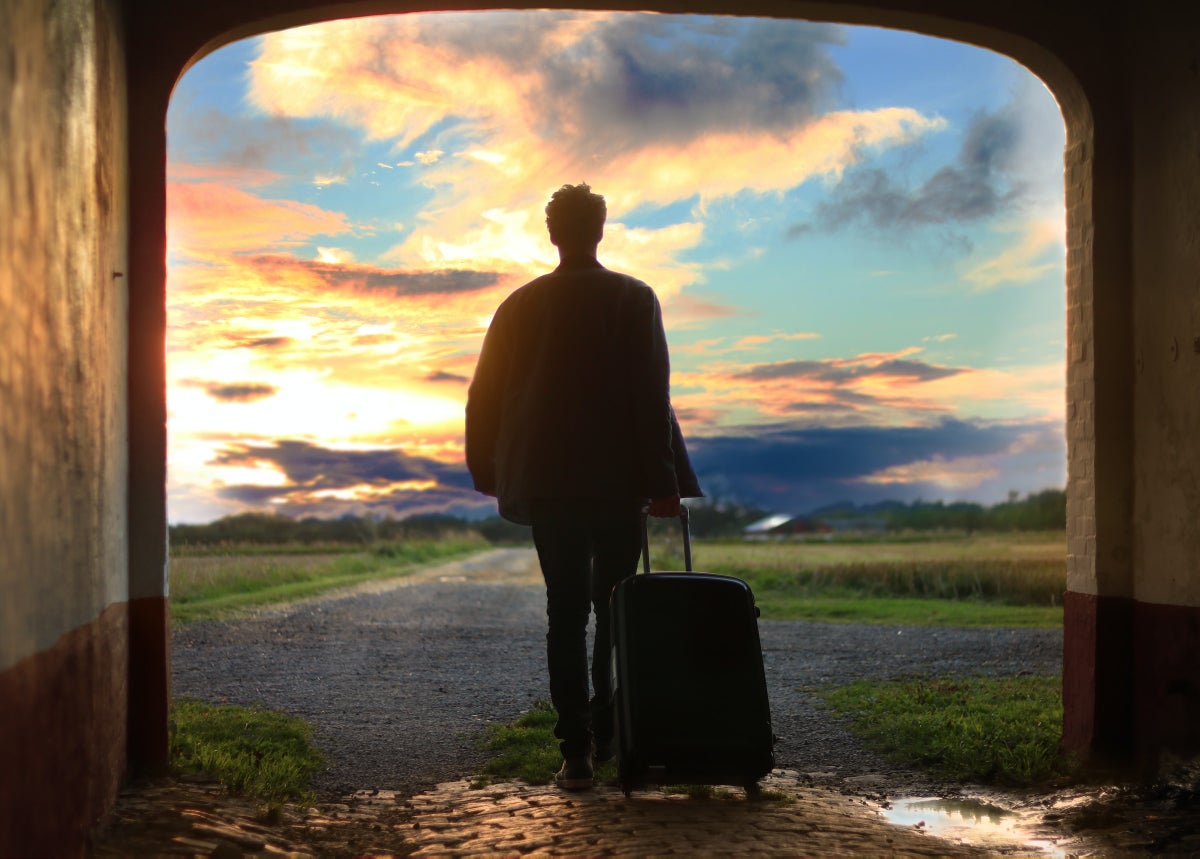
Table of Contents
What is bleisure travel, bleisure travel is trending, bleisure travel offers numerous benefits, bleisure travel benefits both employees and companies, bleisure vs. workcation, how hotels can (and already are) catering to bleisure travelers, bleisure travelers should stay at these hotels, how home rentals can (and already are) catering to bleisure travelers, what to pack for a bleisure trip, final thoughts.
We may be compensated when you click on product links, such as credit cards, from one or more of our advertising partners. Terms apply to the offers below. See our Advertising Policy for more about our partners, how we make money, and our rating methodology. Opinions and recommendations are ours alone.
As corporate and leisure travel have both bounced back after the COVID-19 pandemic, companies, travelers, and the travel industry itself are all figuring out how to navigate the “new normal” in the travel world, which includes concepts like revenge travel, the return of meetings and large events, a major focus on sustainable travel, and a particular concept we’ll focus on with this article: “bleisure travel.”
Business travel was slower to pick back up than leisure travel, but it’s made a comeback in recent months. Now, however, people have a decidedly new outlook on how to handle it, especially now that remote work and hybrid office models have stuck around beyond the end of the pandemic. Corporate travel and personal travel have evolved , and people are looking at these 2 spheres of travel in different ways and combining them like never done in the past.
We’ll discuss the bleisure travel trend, how people are doing it, how it can benefit you, and how the travel industry is (and should be) responding to it . We’ve interviewed professionals in the travel and event planning industry as well as business and bleisure travelers to understand a bit more about why and how this movement is changing the way people travel, work, and vacation.
Bleisure travel is the blending of both business and leisure travel , and it can be manifested in many different ways. Bleisure travel can mean:
- Business travelers who tack on extra personal days before or after a work trip, meeting, or corporate event
- Remote workers who take vacations but can also work remotely from whatever destination they’re in
- Business travelers who bring along friends or family with them to enjoy the hotel or destination while the main traveler is working or in meetings, then take time off to spend with them in the destination
- Any type of trip that combines traveling both for pleasure and professional purposes
We do want to make it clear that bleisure travel isn’t suggesting you take a personal vacation and turn it into a business trip. In fact, it’s really the opposite — ensuring you can make time for leisure and relaxation before, during, or after a work trip or corporate event.
People are more open to bleisure travel than ever before . According to a survey by Booking.com , business travel is picking back up. But in a post-COVID-19 world, employees want team building away from the office, which reflects a feeling that work travel includes “productive play.” In fact, 51% of survey participants are hoping to see their employer use the money saved from the shift to remote work spent on corporate travel and retreats.
And those whose companies have done so seem to have nothing but positive feedback. We chatted with a Paris-based product director in a tech startup who told us his 20-person company has employees around the world in places such as Sweden, France, and the U.S. While he’s able to voluntarily pop into the Paris office a few times a week, he also works from home and connects with his team during the optional quarterly meetup retreats his company offers.
“The trips are fully paid for by the company (travel, hotel, and food), usually a week long in destinations like the Alps, Mallorca, or Marrakech. It’s really helpful to spend time with the team, work in the morning, and do fun activities like yoga or skiing afterward. It’s also such a privilege to bring my family along — my company has even paid for a nanny to help with our 2 children. We work hard all quarter knowing these retreats are coveted rewards that also help with team building and connection,” he explained.
Bleisure Travel Is Everywhere
This move to mix business and leisure travel is happening in all industries and for all kinds of work trips. We spoke to Catherine Chaulet, President and CEO of Global DMC Partners , to understand more about why and how this is happening.
“ The trend to mix work and leisure is requested more and more for groups, meetings, and incentives. Allowing for free time is also now becoming a must. As meeting planners work on attracting attendees to their meetings, incentives, conferences, etc., they’ve had to integrate these into their programs. Attendees want free time to work but also to relax,” she told Upgraded Points.
As combining work and play becomes the norm, travelers, employers, and meeting planners are figuring out ways to incorporate leisure into work travel and events, including adventure, wellness , relaxation, family and friend time, exploring, and beyond.
Not convinced bleisure is for you, or aren’t sure how to incorporate it into your professional life and travels? Read on to find out how.
A study done by the Expedia Group in 2023 showed that 62% of travelers plan to travel in the next few months to relax and disconnect. And this is exactly why you should take a business trip and spin it into a bleisure trip. Why not take a few extra days and turn a work trip into some time to also relax, disconnect, and rejuvenate?
Here are just some of the ways bleisure travel can be beneficial to you.
If your company pays for airfare or you get a discount on additional hotel nights (or you can write the trip off as a business expense), you’re saving money on your vacation . And now, with the cost of airfare and accommodations on the rise, being able to travel affordably is key .
To understand a bit more about how employees can save money on bleisure travel, we spoke to Nick Morse, a Group Category Director at Rubix Group, who frequently travels for work and meetings.
He told us that since the pandemic ended, business travel has picked up once again, and he’s been traveling during weekdays and then using weekends to stay in destinations like London, Germany, and France. “It’s been a great way to get some fresh air and take a break, and at a reduced cost because my air travel is already paid for. When possible, I take my wife along, too, and she has time to relax and enjoy while I’m working; then we take the weekend exploring together, saving us money on a vacation.”
To understand the other side of things, we spoke to Michael Johnson, Senior Events Ninja at Event Dojo , who primarily plans incentives. He told us that he’s started to plan entire leisure days into incentive trips, and has had a 100% positive response from attendees. “People get to enjoy themselves without having to spend their own hard-earned money to do so. Additionally, with the costs of flights soaring, this huge expense is covered by their company, which allows them to extend their stay by a few nights on their own to really make a memorable vacation out of it.”
It’s a Better Use of Time
If you’re already on that 8-hour flight for a business trip, take advantage of this time . You’ve already spent the time flying and overcoming the jet lag. Now you can enjoy a getaway without having to fly long-haul again or catch up on missed sleep.
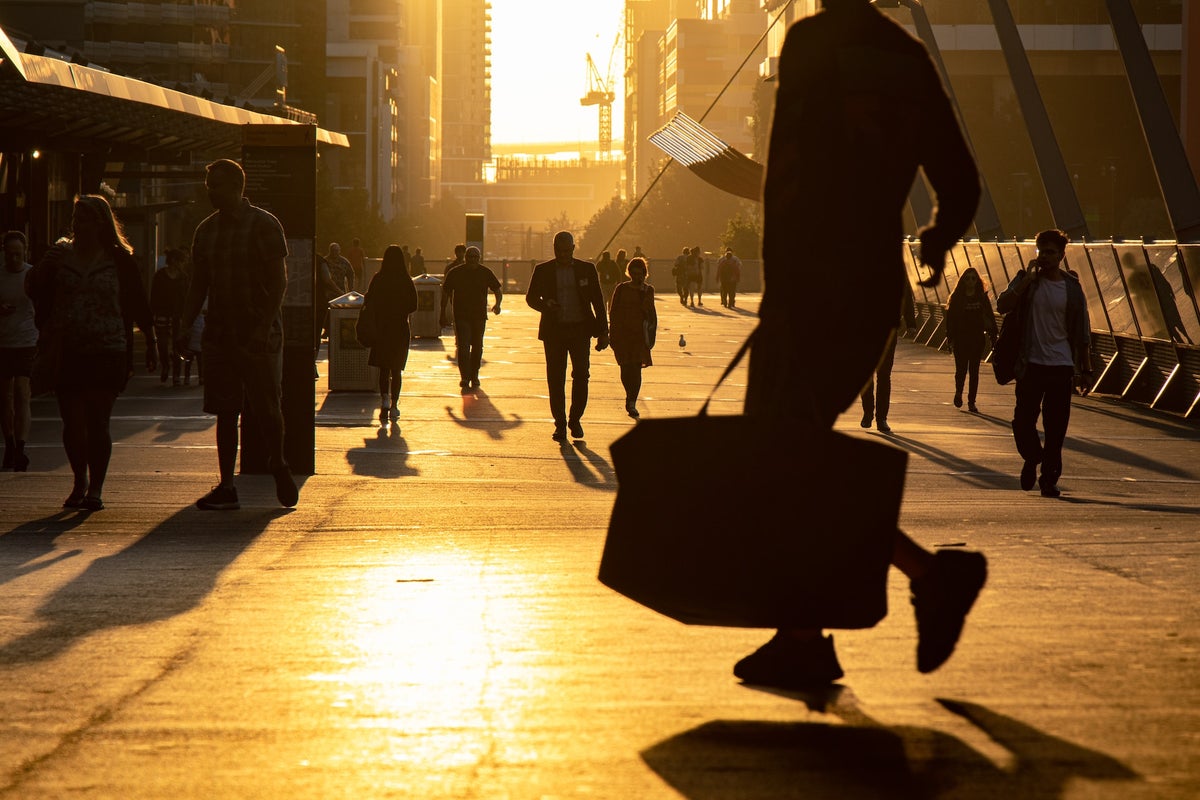
For example, we talked to an IT Project Manager for a global consulting firm who explained he loves flying to destinations that have a 1 to 2 hour time difference, but earlier. “I can get a head start on the East Coast with work, complete all my tasks by about 4 p.m. local time, and then enjoy the beach, restaurants, and nightlife like a local.”
Make Sure You Get the Leisure Time You Need (And Deserve)
According to a study by Pew Research Group , 51% of Americans don’t take all their vacation time. Tacking a leisure trip onto a business trip ensures you’ll take the vacation time you’re entitled to, especially if you don’t have the time and energy to plan a standalone vacation. You earned this time off — take it!
Have New and Memorable Travel Experiences
If you have a business trip or event in a foreign, far-flung destination, you may be exposed to a part of the world or a culture that you may never have gotten to see otherwise. You may even get to visit a state you hadn’t previously considered planning a vacation in. The IT Project Manager told us that his company has a small presence in Brazil, with 3 employees there that directly report to him.
By combining a trip to see the team with a vacation, he could both connect with his team and explore São Paulo. “I used less vacation time by combining a work trip with a vacation, and I was exposed to a whole new culture, which was exciting and novel,” he said.
And people within the travel industry are seeing this type of travel more and more, especially when it comes to meetings and events. Mr. Johnson mentioned that “ After unprecedented lockdowns, we’ve seen more excitement in getting out and exploring the world than in the years previous .”
The next time your company considers that meeting in Buenos Aires, an event in Bangkok, a corporate retreat to Egypt, or even a sales meeting in Wyoming, make sure to take advantage by tacking on a few extra days, turning a business trip into a bleisure experience to see a new place.
Feel More Fulfilled and Become a Better Employee
Rested employees are happy ones, and according to that aforementioned Booking.com study , more than half (59%) of workers around the world believe traveling can help them to be more productive at work, which brings us to our next point: Bleisure travel is good for businesses , too.
With a focus on remote and hybrid work, it’s more important than ever to get employees together — not just in business settings, but in leisure ones, too.
According to Ms. Chaulet, “Corporations sometimes have challenges building team spirit within their companies with staff working from home. Combining business and leisure on these trips helps build this sense of camaraderie among employees. This brings efficiency, better teamwork, and ultimately stronger loyalty to corporations .”
Extending a work trip to include some leisure time, or better yet, having leisure time built into a corporate retreat, event, or incentive trip, can boost employee efficiency, productivity, and fulfillment, leading to happier, healthier, and more loyal employees. This can boost team morale and company productivity , achieving a strong ROI and benefitting the bottom line in the process.
“ Workcations” and “bizcations” are terms that are often used interchangeably with bleisure travel, but it’s important to note that they aren’t the same thing .
Working during what’s supposed to be a relaxing vacation often happens (a workcation). Many Americans don’t take their allotted time off as it is, so if working on a vacation can be avoided, we suggest trying your best to make that happen (we know it’s not always possible). And workcations are also different than working remotely from a new destination — or digital nomad-ing — where you may travel to a place to work “from home” for a significant amount of time, but also build in some leisure or vacation time.
According to a JobSage survey , “More than half (59%) of Americans don’t like the concept of workcations.” And honestly, neither do we. Working during your vacation kinda stinks, after all. But the reality is that many people take workcations because they simply can’t take vacations. Some can’t fully disconnect, while others can’t dedicate the time to really relax and not work. According to the survey, 47% of respondents have taken a workcation because they felt they couldn’t take time off.
Instead of thinking of workcations and bleisure travel as the same thing, perhaps it’s time to think about bleisure travel as a possible solution (or at least a Band-Aid) to banishing workcations .
We can’t expect centuries of ingrained ideas about hard work to dissipate overnight, but perhaps tacking on a few days of “true vacation” after working hard during a corporate trip is a realistic scenario.
Employers aren’t the only ones capitalizing on bleisure to benefit their companies. Hotels are also taking note of this movement and offering amenities and features that benefit bleisure travelers.
IHG, for example, has called it “blended travel,” understanding that flexibility is key when it comes to providing comfortable stays for all kinds of travelers. Ginger Taggart, Vice President, Brand Management, Global Crowne Plaza, said in a white paper discussing the future of travel : “Our guests are looking for more flexibility to rebalance their lives, and we’re continuing to evolve and invest in the blended travel space to provide the lives that they now want to live as they travel.”
The paper states that 60% of U.S. travelers plan to add leisure days to future business travel, so hotels need to be ready, offering elements that bleisure travelers want.
How Bleisure Travelers Can Maximize Hotel Stays
A study by Passport Photo Online showed that 65% of Americans book hotel rooms for work 1 to 4 times a month, and nearly 72% of working professionals plan to use hotels for work in 2023 and beyond, noting that they have higher levels of productivity and creativity when working at a hotel.
According to travelers, things like having their bed made every day ( hotels that are cutting housekeeping — take note!) are really important for creating a comfortable working environment, as are things like plentiful food and drink offerings, speedy Wi-Fi, special discounted rates for those who extend business travel into leisure travel, comfortable in-room workspaces, business-friendly amenities like free adapters upon request or plenty of electrical outlets in guestrooms, a business center or dedicated co-working space, printing options, childcare options, and flexible check-in and checkout times.
The aforementioned study also stated good lighting and quiet rooms as additional wants and needs for bleisure travelers.
Beyond just amenities for business travelers, hotels need to embrace the versatility that a bleisure traveler needs to enjoy themselves during the leisure part of their trip, too, by offering things like pools, fitness centers, beach access, and beyond, all things someone might want to enjoy after a few days of meetings or work events.
Bleisure travelers need the best of both worlds: amenities that benefit business travelers as well as amenities that make for a fun and comfortable leisure vacation. Find a hotel that has it all for the best bleisure travel possible.
Credit Cards, Elite Status, and Rewards Are Key
Holding certain travel credit cards , membership, or elite status can make it easier for travelers to get some of these perks. For example, the Marriott Bonvoy Business ® American Express ® Card offers a 7% discount on standard rates for reservations of standard guest rooms at participating Marriott Bonvoy hotels when booked direct (terms apply), as well as complimentary Gold Elite status , which offers late 2 p.m. checkout (upon availability), among other benefits. The Amex Fine Hotels + Resorts program offers early check-in when available and late checkout at 4 p.m.
Looking to capitalize on hotel benefits like late checkout? A host of c redit cards offer hotel complimentary elite status so you can take advantage of perks like free Wi-Fi, late checkout, early check-in, and much more
These benefits can provide essential value for bleisure travelers. The IT manager we spoke to told us, “When I go to European destinations like Madrid, I stay in hotels with free and fast Wi-Fi and work U.S. ET hours. This frees up my morning on Central European Time for exploring the city, cafes, etc., and as Madrid has a later nightlife, I still have time for dinner after work. Without early check-in, this would be more difficult. And thanks to late checkouts due to hotel [elite] status, I can often put in 8 hours at a hotel on the day of departure and then fly home or onwards to another destination for some additional time off. That certainly helps, too.”
The Future of Bleisure Travel Rewards
Mr. Johnson looks at these types of perks from the eyes of an event planner, floating the possibility that hotels could further reward business travelers that tack on additional leisure days after meetings and events. “I’d love to see hotel properties get creative with how they reward and incentivize business and bleisure travel , especially for meetings and incentives attendees,” he said.
And we’re hoping to see the same. We think that beyond just a variety of amenities, hotel loyalty programs should incentivize business travelers with discounts, additional points, and perks, encouraging them to become bleisure travelers, which is a win-win for everyone.

Obviously, you can’t always pick where your company is hosting a business trip, meeting, or corporate retreat. But if you have any say in the matter or are able to work remotely, consider these hotel brands, which offer amenities and perks to bleisure travelers, digital nomads, and remote workers . Likewise, meeting planners and corporations should take note of which hotels are catering their offerings toward bleisure travelers.
Hyatt Hotels
Hyatt’s Work from Hyatt program offers hotel rooms for daily work use, but bleisure travelers should perhaps consider its Great Relocate program, ideal for digital nomads and remote workers who want to combine working with a vacation for a period longer than 29 days. Find this program in 125+ hotels throughout Africa, Europe, India, and the Middle East, including popular destinations like Paris and Dubai. It offers perks like discounts on laundry services and complimentary boardroom access.
Loyal to Hyatt? Get The World of Hyatt Credit Card to earn bonus points on Hyatt hotel stays.
Crowne Plaza Hotels
Crowne Plaza’s Plaza Workspaces are hybrid spaces designed to adapt to whatever a bleisure travel needs, from co-working and collaboration spaces to large meeting rooms. Find them at Crowne Plaza locations in cities including Atlanta and Los Angeles.
Arlo Hotels
This trendy boutique chain has business offerings like cool co-working spaces and rooftop bars for when you’re ready for an after-work drink or weekend hangout spot. Booking an Arlo Means Business stay means you’ll get 40% off the best available rate , waived urban fees, and late checkout when available. Arlo properties are located in Chicago, Miami, and New York.
Home rentals are also an easy way to combine meetings, remote work, or corporate travel of any kind with a leisure trip . They’re especially ideal for longer trips or for anyone who wants to work remotely but also take time off for a vacation, too.
How Bleisure Travelers Can Maximize Home Rentals
Websites like Airbnb have filter options like “dedicated workspace,” and you can also filter for any leisure amenities you’d like to have from pools to BBQ grills and more.
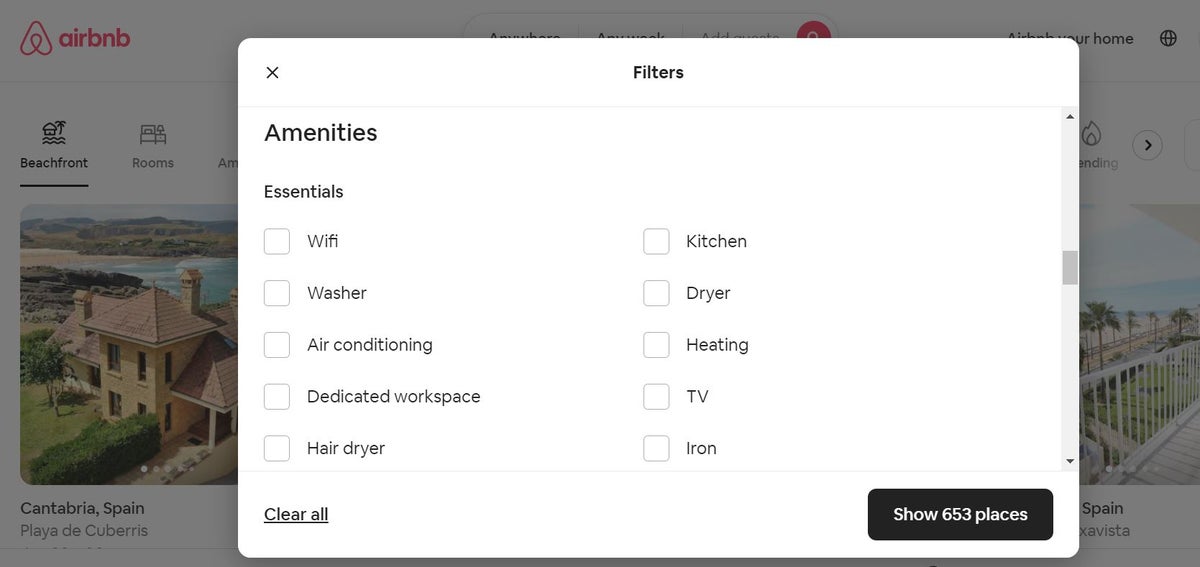
Some vacation rentals also offer long-term discounts for week or month-long stays that can make them more affordable for bleisure travelers. Some may even have multiple work areas, relaxing outdoor spaces, or office supplies, or are kid- and pet-friendly so you can take the whole family along. VRBO allows users to filter properties by “family-friendly,” ideal for bleisure travelers who want amenities for the kids like high chairs, cribs, play areas, etc.
It’s always a good idea to read reviews and see what people say about working remotely at a given property. Message the host to check the Wi-Fi speeds, too!
One senior marketing executive at a New York City-based media agency told us he loved a recent bleisure trip to Mexico, thanks to an incredible rental he was able to find. He was there for almost 4 months, working during the week and taking long weekends to relax, unwind, and discover more about the local culture. “The most important amenities to me were speedy Wi-Fi and organizing with the host to have a weekly cleaner, with whom I was able to chat and practice my Spanish. It felt like home and was the perfect place to decompress and have a vacation after long work days,” he said.
How Rental Property Hosts Can Cater to Bleisure Travelers
If you’re a host, make sure to update your listing and explain why it’s a great fit for business or bleisure travelers, take photos that accurately reflect workspaces (extra points for Zoom-friendly backgrounds) and leisure amenities, and offer discounts for longer stays . You can even include words like “leisure,” “business,” “digital nomad,” or “remote work” in the description. Extra amenities, such as complimentary office supplies or well-stocked kitchens, can go a long way, too.
Every bleisure trip is different, of course, but it’s best to pack day-to-night pieces that can work for both a meeting and a leisure activity, like dinner or a stroll around town. Obviously, weather and destination are both big factors when it comes to packing, but packing layers is a good idea, as well as pieces that can pull double duty. A mix-and-match capsule wardrobe that works for a variety of occasions and situations is key.
When in doubt, make sure you concentrate on business wear because it’s a lot easier to pick up a swimsuit coverup or sunglasses at the hotel gift shop or in town than it is to find a perfectly tailored suit. Don’t forget any gear you’ll need for work, like a mouse, chargers, microphone, headphones, etc., and throw in your favorite vacation items, too, like that beloved baseball cap and a good poolside read.
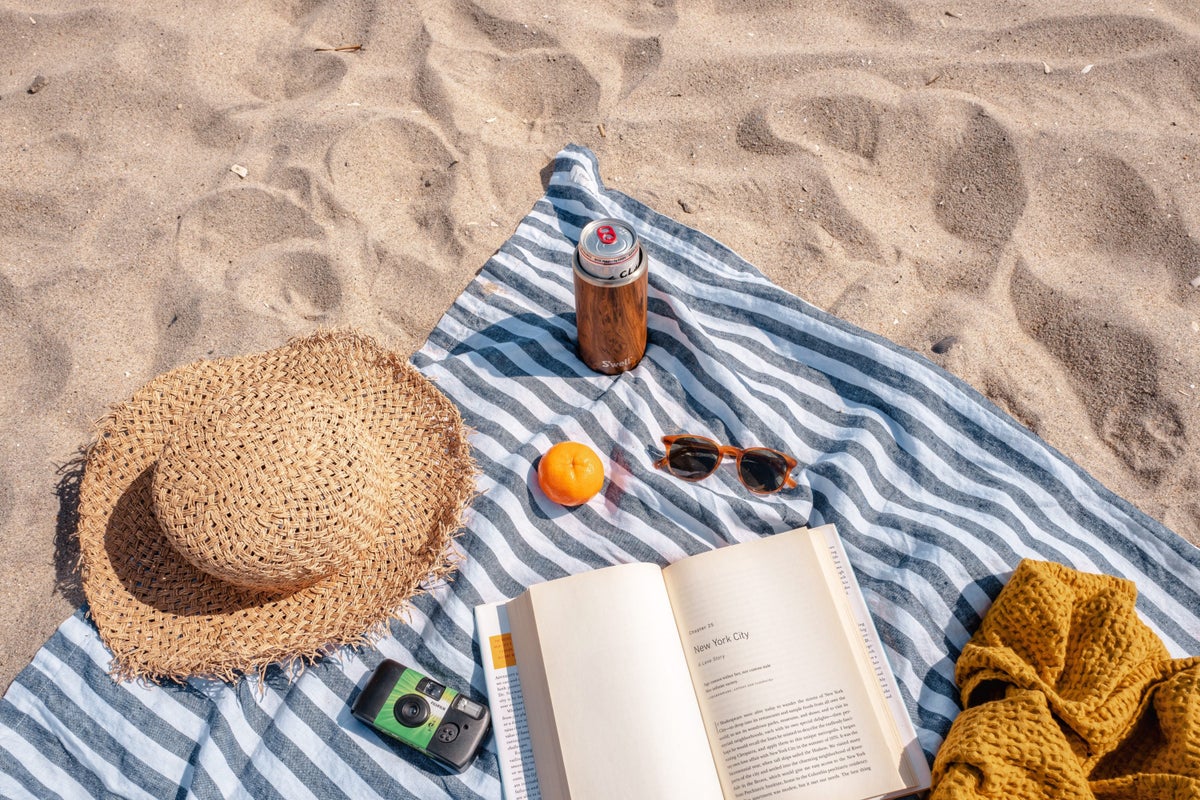
Bleisure travel is trending, and we don’t see it going anywhere anytime soon . As Ms. Chaulet put it, “Bleisure is much more convenient today,” and we couldn’t agree more. Take advantage of that company-funded plane ticket and add on a few vacation days after a business trip. You’ll likely return home a healthier and happier employee.
For rates and fees of the Marriott Bonvoy Business ® American Express ® Card, click here .
Frequently Asked Questions
What are the benefits of bleisure.
Bleisure travel has numerous benefits. To start, it can benefit the traveler, because they can save money and time while having leisure and vacation time during a work or corporate trip. It also helps companies, as employees are happier and better rested after a bleisure trip. Finally, hotels can benefit from customers staying longer by adding additional days to a corporate trip, event, or meeting.
What is the concept of bleisure?
Bleisure is the combination of business and leisure travel. It refers to anyone that takes a work trip but also enjoys a vacation, too. Post-pandemic, bleisure travel has become very popular, as flexible work schedules make the concept easier to manifest.
What is the difference between workcation and bleisure?
A workcation isn’t as great as it sounds. It happens when you take a vacation but end up doing work. In contrast, a bleisure trip is taking a work trip and adding an element of vacation to it.
What does bleisure mean in tourism?
Bleisure is the combination of 2 types of travel: business and leisure. Bleisure travelers usually work or are in meetings during the day, but enjoy tourism during the vacation element of their trip.
Was this page helpful?
About Lori Zaino
Lori is an intrepid traveler who loves creating itineraries that exude “luxe on a budget.” She’s written for CNN, NBC, The Infatuation, and more, and loves to muse about points-fueled trips to Sri Lanka, Sicily, and Myanmar.
Discover the exact steps we use to get into 1,400+ airport lounges worldwide, for free (even if you’re flying economy!).
We respect your privacy . This site is protected by reCAPTCHA. Google's privacy policy and terms of service apply.
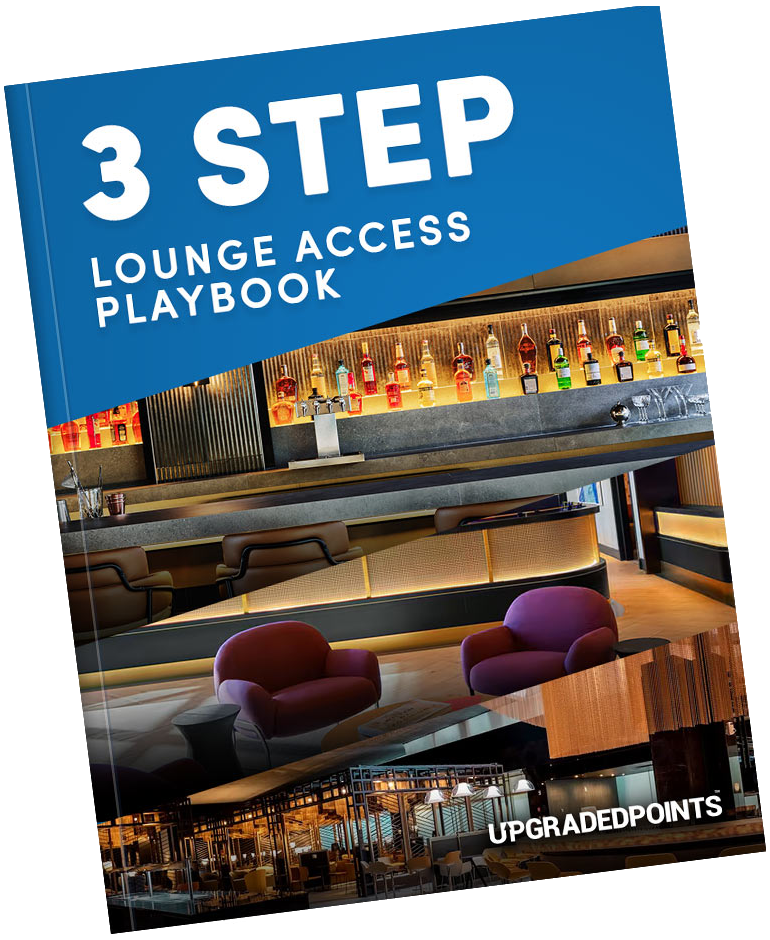
Related Posts
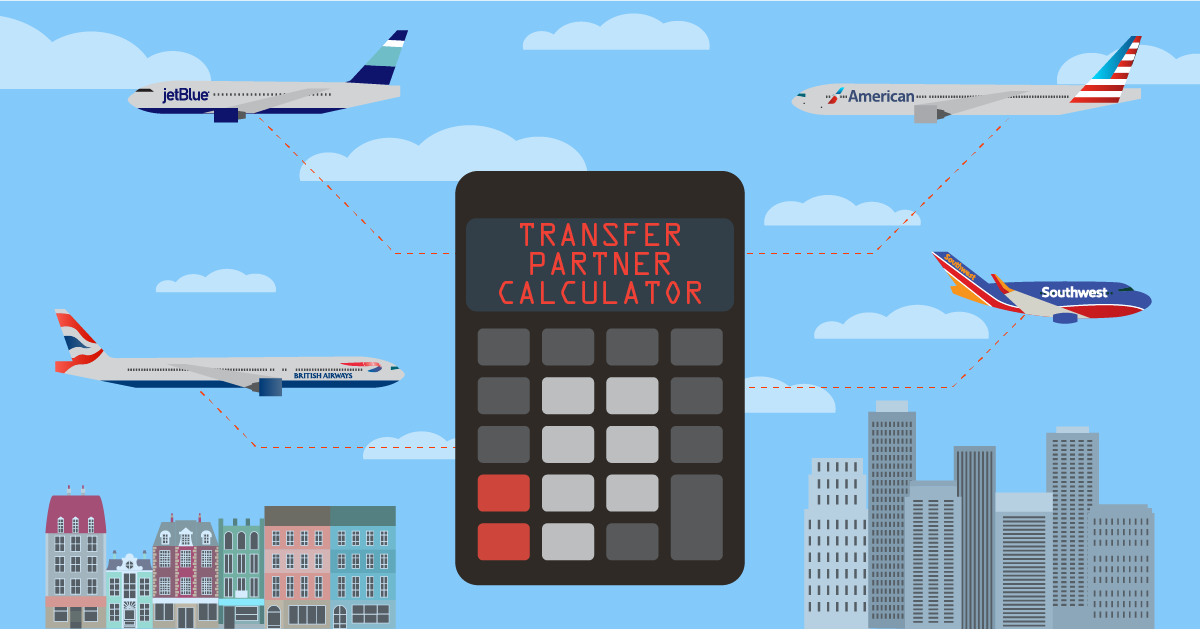
UP's Bonus Valuation
This bonus value is an estimated valuation calculated by UP after analyzing redemption options, transfer partners, award availability and how much UP would pay to buy these points.

How to Use Bleisure Travel to Extend Your Vacations
Workcations, bleisure trips, blended travel—whatever you want to call it, the vacation hack of extending business trips into leisure getaways is here to stay. use these tips to plan them smartly..
- Copy Link copied

More and more, travelers are combining work trips with vacations.
Photo by Michelle Heimerman
If you’ve ever seized the opportunity to spend a few days exploring a new city after a work conference or arrived in town ahead of a client meeting to relax on the beach, go on a hike, or check out a touted restaurant, congrats—you’ve indulged in the art of “bleisure travel.”
The term bleisure refers to combining business and leisure in a single trip. This trend, also referred to as “workcations” and “blended travel,” was well underway before the COVID-19 pandemic and has skyrocketed since, undoubtedly buoyed by the return of business travel and the prevalence of remote and hybrid work.
How popular is this trend? According to last October’s Amex Trendex: Business Travel Edition , 8 out of 10 business travelers said that they had extended a business trip in the past year to work remotely from their travel location or for leisure travel. And per research compiled by online business-travel management company Navan , there was a 72 percent year-over-year increase in blended travel bookings during the first 10 months of 2023 (January through October), compared to the same period in 2022. Additionally, 24 percent of travelers planned to have a friend or relative join them on a business trip in 2024.
The perks of bleisure travel are clear: You are already there and may not need to pay for your flight entirely out of pocket to enjoy a fabulous destination. Whether you are embarking on your first bleisure adventure or your ninth, here are some strategies for elevating your bleisure travel game.
1. Check your company’s bleisure travel policies.
Avoiding reprimands is key for an enjoyable bleisure trip, so get acquainted with your company’s guidelines on extending business travel. This includes knowing the level of flexibility for arriving at your destination early or leaving late, especially if there is a difference in the cost of your flights; understanding how to properly file expense reports; confirming permitted activities during business trips; and determining whether bringing companions is allowed.
2. Take advantage of weekends and public holidays.
If you hope to partake in bleisure travel without sacrificing precious vacation days (and who wouldn’t?), consider strategically planning your business trips either right before or after a weekend. For an extended getaway, aim to schedule around a public-holiday or long weekend to maximize your time at the destination while keeping your PTO balance intact.
3. Pack versatile clothes.
Bleisure travel essentially involves two trips in one, which can present a packing challenge. Select versatile and comfortable wardrobe pieces that transition from the boardroom to a leisurely walking tour (like these editor-tested travel pants ). Sticking to a cohesive color scheme, a proven travel tip, can save space in your luggage. ( Packing cubes can help too, as can a one-bag strategy. )
4. Think ahead when making hotel reservations.
Combining business and leisure travel means that you will need to make separate hotel reservations, one for the company-covered leg of the trip and one for your personal time. If you want to stay in the same room at the same hotel for the duration of your stay (a good idea, as it will save you time), contact the hotel in advance and request to stay in the same accommodations from check-in to checkout.

Service unavailable in your location
Unfortunately Booking.com for Business is currently not offering its services in your location
See how Cvent can solve your biggest event challenges. Watch a 30-minute demo.
Bleisure Travel: Mixing Business with Pleasure

Business travel consistently increased over the last decade, and is now mounting its post-pandemic comeback. More and more working people are finding themselves on the road quite often, but a life of all work and no play isn’t very appealing. As a result, bleisure travel is growing and proving to be a profitable market in the hotel and travel industries.
In this post, we’ll be breaking down bleisure travel trends, facts, figures, and marketing strategies to help hotels appeal to this rapidly growing market. We’re breaking down what the market is, why it’s growing, and helping hotels develop profitable marketing strategies to capitalize on the growing travel trend.
Boost your hotel revenue and increase your bleisure travel
Hotel managers should always be on the lookout for new revenue opportunities. As the hotel industry becomes more competitive, hoteliers know how important it is to reach all profitable markets. Add bleisure travel to your sales and revenue strategy to boost business.
What is bleisure travel?
Bleisure travel is a growing market segment in the travel world. A combination of business and leisure travel, bleisure travel blends the worlds of work and play . Travelers in the bleisure market often add additional nights to their overnight business trips, using the extra time to enjoy leisure activities while they’re out of town.
Bleisure travelers choose to extend their stays for a variety of reasons: ● Visit friends and family in the area ● Experience local culture, cuisine or attractions ● Attend area festivals, tournaments and other events ● Explore outdoor recreation opportunities ● Enjoy a little peace and quiet or alone time

Are there different types of bleisure travel?
While all bleisure travel is an amalgamation of business and leisure travel, revenue planners, hoteliers especially, further segment bleisure travel in their marketing strategies. Hotel managers break bleisure travel down more so that they can identify business travel demand generators , as well as an individual's reasons for extending their stay to accommodate leisure.
Bleisure travel can be broken down into two primary categories: extended solo business travel and business travel with friends or family.
Extended business travel for the solo traveler As the global workforce grows, more and more workers find themselves traveling for business. When we take a closer look at the business end of bleisure travel, most travelers who add leisure days to their work stay are traveling for a few primary reasons. Data shows that:
● Group business travel (e.g. conferences, conventions, etc.) accounts for 43% of bleisure travel. ● Sales trips account for around 9% of extended bleisure stays. ● 24% of bleisure tourists are travelling for off-site team events.
A lot of solo bleisure travel revolves around relatively infrequent events. Annual conferences, for example, only take place once a year and may be the traveler’s only opportunity to experience the destination. This occasional travel inspires guests to spend additional time in their destination to take in all it has to offer.
Business travel with friends and family
Travelers going to exciting destinations for work may choose to bring their family or friends along for a vacation. This trend is growing, especially amongst younger generations, as the idea of sacrificing family time for work is becoming more taboo. In fact, today’s savvy young worker seeks out hiring companies that offer generous time-off and travel benefits, often looking for bleisure benefits specifically.
Why is bleisure travel popular?
Whether it’s to check out a concert, hike a gorgeous mountain, or simply get some alone time, extending business travel for pleasure works for workers’ schedules as well as their wallets. For many, adding a mini-vacation at the end of a business trip is more affordable than trying to book separate holiday-only travel. Often, bleisure travelers take advantage of unused vacation days at the end of a work trip for a long weekend of fun.
Understanding the bleisure travel trend
In the early 2010’s, there was some debate between industry experts about whether or not the bleisure trend was real. Were more people really extending business travel to accommodate personal time? As new generations begin to dominate the workforce, traveling all over the world for business, the answer is a resounding, “yes!”
While the growth of bleisure travel stalled between 2011 and 2016, hotels saw a significant increase in blended travel come 2017. Bleisure increased 20% from 2016 to 2017 , and the market has continued to grow. As more millennials enter the workforce, they are a dominating demand driver for hotels. Around 40% of millennials travel for work , and 55% of all business travelers are aged 30-49.
While millennials do make up the largest segment of the bleisure market, data shows that travelers of all ages are adding leisure days to their business travel. Bleisure travel is popular among age demographics as well as a wide variety of income levels.
What effect does bleisure travel have on the hotel industry?
As the amount of bleisure travel demand grows, hotels are fighting to get their fair share of the lucrative market. Hotel revenue is becoming more reliant on the success of bleisure travel. Hoteliers who focus on bleisure travel, and increase their efforts to attract it, will be greatly impacted.
By appealing to the bleisure market, hotel managers are:
● Encouraging longer guest stays.
40% of business travelers recently extended their work-related hotel stay to accommodate leisure activities, increasing average occupancy rates and promoting ADR growth. Even when shoulder night rates are higher, bleisure travelers who are satisfied with their hotel accommodations are unlikely to move properties to save a few bucks. ● Directly connecting hotels to their guests.
Travel accommodation options used to be solely decided by a few white-collar big wigs in the corporate travel office and employees were told where to stay. The discussion of company travel, however, has become a much more communal conversation over the last few years.
As the voice employees have in decision making grows, hotels are seeing the impact directly. The majority of bleisure travelers book their own leisure-based hotel stay, and often put pressure on their company’s travel department to consider their preferences.
● Building relationships with businesses who offer attractive employee benefits.
Companies who offer bundled business/leisure travel discounts are drawing a lot of attention from prospective employees. As the societal demand for a healthier work-life-balance grows, employees are actively seeking employers who offer benefits that fit that goal.
How can I capture more bleisure travel to boost hotel revenue?
Review your revenue plans and marketing strategy to see what bleisure travel strategies are already in place. Do they need improvement? Do they currently exist at all? Spice up your bleisure marketing with these best practices.
1. Inquire about potential bleisure needs with corporate accounts during your quarterly account maintenance calls. Contact the bookers for your top accounts regularly and inquire about upcoming on-site training, conferences, union negotiations or other events that may require a lot of travel to your town. Pin down high-demand dates and match them with local events to create unique promotions that appeal to your best corporate guests.
2. Market to the bleisure segment through 3rd party booking sites. Review OTA booking sites (hotels.com, orbitz.com, etc.) looking for competition hotels in your area. If your competition is marketing in locations that you are not, you’re missing out on revenue streams. Review OTA reports to see if you’re inactive on third party sites prevalent in your area.
3. Choose the best distribution channels to partner with before allocating marketing dollars. Discuss trends with your ownership company, revenue management team, and brand consultants to develop a strong distribution strategy .
4. Promote local attractions and events on social media to build relationships with vendors , businesses, and event venues that attract bleisure travelers to your area. Regularly tag, share content, and engage with top performing area social media accounts to boost your audience visibility.
5. Offer extended business group rates for shoulder night bleisure stays after speaking with your corporate event and booking contacts. Advertise discounted shoulder night rates to event and convention attendees to entice travelers to arrive early or stay late to experience some local fun.
6. Provide exclusive amenities or add-ons to bleisure travelers with promo or coupon codes. By adding a personal touch specific to your guest’s reason for travel, your property is targeting their marketing and building a relationship with future repeat customers.
A complimentary bottle of wine, guide to local attractions or a welcome basket with fresh fruit will go a long way with bleisure travelers. Order giveaways in advance, and include a hashtag or event tag guests can use to share posts about their experience. It’ll help build your online engagement numbers and create a future revenue pipeline.
7. Appeal to business travelers with internet cafes, digital workspaces, etc. Bleisure travelers want to transition from work to play seamlessly. Showcase private work areas in your hotel that offer the privacy and digital amenities today’s bleisure traveler needs to work remotely and get things done.
8. Train staff to connect with bleisure guests by discussing local attractions with callers and uncovering their reason for travel during check-in.
9. Promote fun and easy-to-access attractions that appeal to travelers with limited leisure time. Bleisure travelers who are able to extend for one extra night may not have time for a ten-hour hike, for instance.
10. Encourage repeat stays by engaging directly with bleisure travelers and appealing to their travel needs. Send surveys, promote one-on-one conversations during check in, measure demand drivers , and stay in close communication with the contacts for your top corporate accounts. When an annual event wraps, hotel managers should already have a plan in place to market to the bleisure attendees for that demand generator next year.
Explore hotel technology to accommodate bleisure travelers
1. How do hotels attract bleisure travelers?
The key to appealing to bleisure travelers is providing an easy-to-book travel experience that meets their business and leisure needs at once. Promote property amenities that will help streamline the workday, such as an all-hours coffee bar or private high-speed workstations. At the same time, promote local attractions, unique events, shopping or restaurant discounts, and outdoor recreation opportunities. Hit all of the points on your future guests’ checklists in your marketing.
2. Do millennials book bleisure travel?
They certainly do! The bleisure travel trend is growing amongst all generations, but millennials are spearheading this shift in travel trends. As millennials become a larger part of the workforce, more and more are booking work-related travel. Around 90% of millennials say they have engaged in bleisure travel. That’s almost all of them!
3. What is a bleisure tourist?
A topical, trending travel term, “bleisure tourist” refers to individuals who regularly extend their business travel to include leisure time. They have a habit of adding a few days here and there to experience new travel destinations, take in unique sights, and explore their business-related travel locations.
4. What do bleisure travelers want?
Bleisure travelers are looking for customized, thoughtful and convenient accommodations that easily help them switch between being on and off-the-clock. When booking hotel rooms, bleisure guests prioritize the proximity of their accommodations to their place of business coupled with proximity to area attractions, quick service, personalized experiences, and a seamless digital connection.

Kim Campbell
Kim is a full-time copy and content writer with many years of experience in the hospitality industry. She entered the hotel world in 2013 as a housekeeping team member and worked her way through various departments before being appointed to Director of Sales. Kim has championed numerous successful sales efforts, revenue strategies, and marketing campaigns — all of which landed her a spot on Hotel Management Magazine’s “Thirty Under 30” list.
Don’t be fooled though; she’s not all business! An avid forest forager, post-apocalyptic fiction fan, and free-sample-fiend, Kim prides herself on being well-rounded.
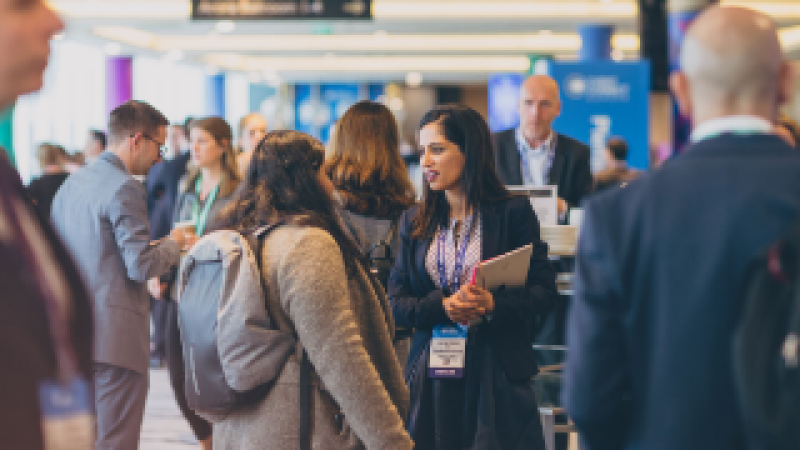
More Reading
Congratulations to the 2024 excellence awards winners, unlock excellence: premier meetings in los cabos await, congratulations to the 2024 cvent excellence awards finalists.
Subscribe to our newsletter

Bleisure Travel for Hotels and Destinations: 17 Expert Tips to Keep Your Guests Coming Back
Increase bookings and revenue by embracing the booming bleisure travel trend for hotels and destinations! Our expert tips help you cater to travelers seeking to blend work and play.
As professionals strive to make the most of their time outside the office by discovering new places and immersing themselves in diverse cultures, the popularity of bleisure travel – blending work and play – has skyrocketed. Catering to bleisure travelers can increase bookings and revenue, as these travelers often have more disposable income and the flexibility to extend their stays. To help you make the most of this growing trend, we’ve compiled a list of seventeen expert tips on embracing bleisure travel for hotels and destinations.
How Hotels and Destinations Can Embrace Bleisure Travel
The travel industry has faced many challenges recently due to the pandemic, a shift towards remote work, and decreased business travel. Inflation and economic instability have also impacted the travel industry. The industry continues to adapt to these changes and prove its resilience. At the same time, these challenges marked a new era for travel, perceived now as the ultimate standard for luxury. Whether traveling for work or vacation, people are now looking to get the most out of their trips.
There are countless ways to cater to the unique interests and requirements of bleisure travelers. Alongside our expert tips, we’ll showcase six inspiring examples of hotels and destinations that have mastered the art of appealing to bleisure travelers.
When Business Meets Leisure: Who is the Bleisure Traveler?
As the saying goes, “work hard, play hard” – this constant desire for an excellent work-life balance is a mindset tied to how the bleisure traveler thinks. The term bleisure is a portmanteau of business and leisure. The trend started in the early 2000s and has gained popularity due to the rise of remote work and flexible schedules, making it easier for individuals to extend their business trips for leisure.
Bleisure travelers are typically professionals who have the flexibility to mix business with pleasure and are looking for hotels and destinations that cater to both. They tend to be more affluent and willing to splurge on leisure activities. They travel more frequently and usually benefit from extended stays, making them a unique audience for the hospitality industry.
It’s a sure thing! They want the best of both worlds, including business facilities like fast WiFi and meeting rooms and also leisure amenities like fitness centers and swimming pools. The bleisure travelers value immersing themselves in the local culture and trying new experiences during their trips. When choosing a workspace, a fast and reliable internet connection, comfortable seating, and access to printing and copying facilities are top priorities for digital nomads . They also value working in a quiet, private space and accessing a community of like-minded professionals.
The Secret to Attracting Business Travelers and Pleasure-Seekers
Catering to bleisure travelers can boost occupancy rates and increase revenue. However, attracting this type of visitor requires a different approach than targeting only leisure or business travelers. To help your hotel or destination, we’ve gathered seventeen expert tips to help elevate your offerings and attract bleisure travelers.
Tips for Hotels
#1 Provide Flexible Check-In/Out Options for Maximum Convenience
One of the top priorities for bleisure travelers is having control over their schedule, and offering flexible check-in and check-out times can be a game-changer. By allowing guests to choose their preferred times, you can increase their satisfaction and make their experience more convenient. This is especially important for those with early or late business meetings.
#2 Create Comfortable Workspaces with Top-Notch Internet
Bleisure travelers often require dedicated workspaces to remain productive during their stay. To cater to this need, offering comfortable workspaces with a fast and reliable internet connection, comfortable seating, and access to printing and copying facilities can attract them to your hotel.
#3: Enhance Productivity with Tech Support and Rental Services
Efficiency is crucial for digital nomads. Make sure that rooms have comfortable working desks and chairs. If you offer co-working spaces, equip them with monitors, sockets, and adaptors. Keep the cables organized and the coffee close to the co-working space.
#4: Keep Your Guests Fit and Healthy with a Gym or Fitness Package
Fitness is essential to many travelers, and offering a gym or fitness package can help attract and retain bleisure travelers. They will appreciate the possibility of keeping their home routine in terms of physical activity – and taking a break from work.
#5: Impress with a Variety of Food & Drink Options
Bleisure travelers often want to experience the local culture and try new cuisines. A carefully crafted F&B experience, including local cuisine, can appeal to them and add value to their stay.
#6 Reward Both Business and Leisure Travel with a Loyalty Program
A loyalty program that rewards those traveling for both business and leisure can increase the return rate of your guests.
#7 Highlight Your Bleisure-Friendly Amenities in Marketing Materials
Make sure to highlight the amenities and facilities tailored to bleisure travelers in your online listings and marketing materials. Include pictures of dedicated workspaces, fast WiFi, meeting rooms, and flexible check-in and check-out times.
#8 Listen to What Your Guests are Saying
Use Post-Stay Surveys to capture as much information as possible. Personalize your survey and questions to get the data you need. The insights will help you refine the guest experience, and other travelers will be more inclined to book their next stay with you.
Track one of the essential categories for bleisure travelers: WiFi . Our latest data shows that WiFi is the #1 factor that can decrease your performance score. It proves that a stable and reliable internet connection is essential for every guest.
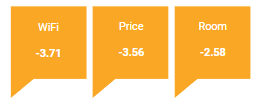
Tips for Destinations
#1 Entice Travelers with Diverse Leisure Activities
Offering diverse leisure activities like outdoor recreation, cultural events, and local attractions can appeal to bleisure travelers who want to mix work and play.
#2 Share the Unique Cultural Experiences the Destination has to Offer
Promoting unique cultural experiences, such as local cuisine, arts and culture, and history, can help attract bleisure travelers who want to immerse themselves in the local culture.
#3 Promote Accessibility and Ease of Travel
Highlighting the destination’s accessibility, such as its proximity to major airports and transportation options, can make it easier for bleisure travelers to plan their trip.
#4 Provide a Variety of Accommodation Options
Offering various accommodation options, such as hotels, vacation rentals, and serviced apartments, can help attract bleisure travelers who want flexibility and choice.
#5 Connect Bleisure Travelers With a Sense of Community through Events and Local Connections
Host networking events and connect bleisure travelers with local entrepreneurs and freelancers. This can create a sense of community for bleisure travelers and help them feel more connected to the destination.
#6 Partner with Local Businesses to Offer Memorable Bleisure Experiences
Partnering with local businesses to offer packages, such as dining, tours, and activities, can help bleisure travelers save time on planning.
#7 Encourage Repeat Visits with a Bleisure-Friendly Loyalty Program
Loyalty programs can be a powerful tool for building loyalty and encouraging repeat visits among bleisure travelers, who may be more likely to return to destinations where they feel valued and appreciated.
#8 Support Sustainable Tourism Practices
Promoting sustainable tourism practices, such as environmentally-friendly accommodation options and responsible tourism activities, can help attract bleisure travelers who want to travel responsibly and sustainably.
#9 Measure Your Performance and Competitiveness:
Look at what your visitors are saying. By understanding thousands of hotel reviews, you can drive better business decisions for your destination , measure performance, and identify unique selling points and areas of improvement.
Bleisure Travel Takes the Lead: Real-Life Examples from Hotels and Destinations
Let’s dive into the world of successful hotels and destinations that have embraced the bleisure travel trend. Buckle up, and let’s see how these industry leaders have adapted their offerings to meet the demands of the modern traveler.
Hotels Embracing Bleisure Travel
#1 Apartments by Marriott Bonvoy
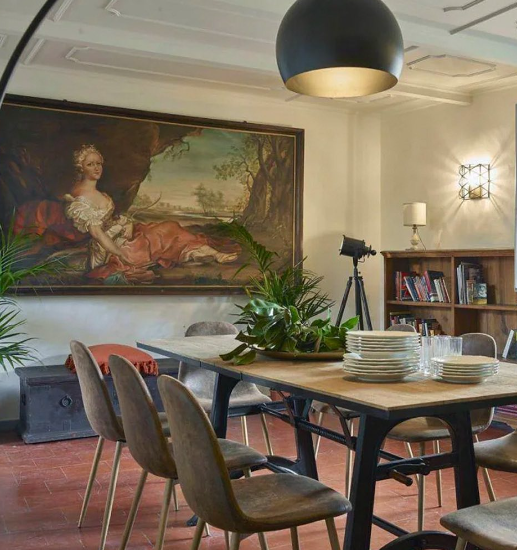
Marriott International has launched Apartments by Marriott Bonvoy to cater to the growing demand for bleisure travel by providing travelers with flexible and spacious extended stay options. The brand offers a home-away-from-home experience with hotel-style amenities to meet the unique needs of bleisure travelers.
#2 Hilton Aruba Caribbean Resort & Casino
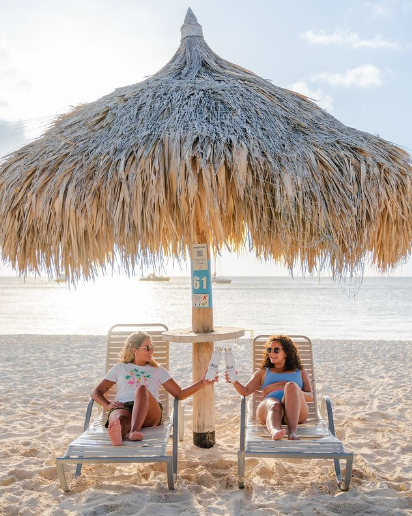
Hilton knows how important it is to stay connected and energized while on vacation. That’s why they’ve introduced their Power Palapa offer – the ultimate solution for modern travelers who want to blend work and leisure. The Power Palapa is the perfect place to recharge physically and technologically. The offer includes a power and USB charging station, a laptop cooling pad, a sunshade privacy cover, bottled water, and a power bowl with hydrating aloe juice or coconut water. It is a perfect place for guests who want to bring their work to the beach while enjoying the sound of the waves.
#3 Four Seasons Hotels and Resorts
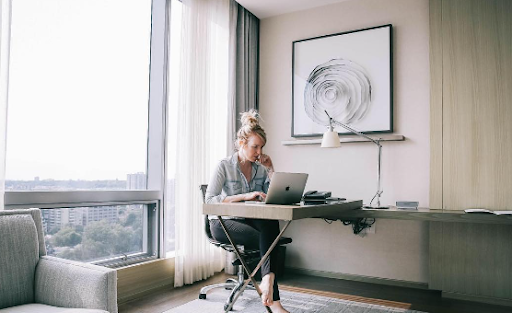
Four Seasons Hotels and Resorts are known for their luxurious accommodations but also cater to the growing trend of bleisure travel .
Recognizing the need for travelers to blend work and leisure, Four Seasons offers services and amenities to make it easier for guests to stay productive while enjoying their travels. Four Seasons ensures business travelers have everything they need to get work done, from spacious rooms equipped with ergonomic workspaces to in-room technology, such as high-speed wifi and printing services. Many hotels offer coworking spaces, allowing travelers to network and collaborate with like-minded individuals. They offer the comfort, convenience, and luxury travelers expect while providing the services and amenities needed to make the most of work and leisure time.
Destinations Embracing Bleisure Travel
#1 Barcelona
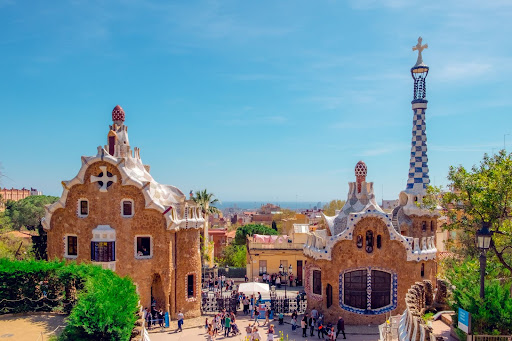
This vibrant city boasts a rich history, and it has a high concentration of coworking spaces and cafes with good WiFi, world-class cuisine, and a range of leisure activities sure to captivate travelers. The diverse cultural scene and the sense of community make it a top destination for bleisure travel.
The Barcelona Workation program , launched by Turisme de Barcelona and the Barcelona Provincial Council, aims to attract digital nomads, freelancers, and digital professionals. The program offers accommodation and special deals on cultural and leisure activities to enable professionals to work and live like a local in Barcelona. The Barcelona Card Workation provides discounts and free admission to museums and attractions. The surrounding areas of Barcelona offer diverse experiences such as beaches, fishing villages, vineyards, mountains, art and cultural heritage, culinary delights, and health-giving thermal springs.
By providing a well-rounded, work-friendly destination, DMOs can make their cities or regions a top choice for bleisure travelers and boost the local economy.
#2 The Island of Bali
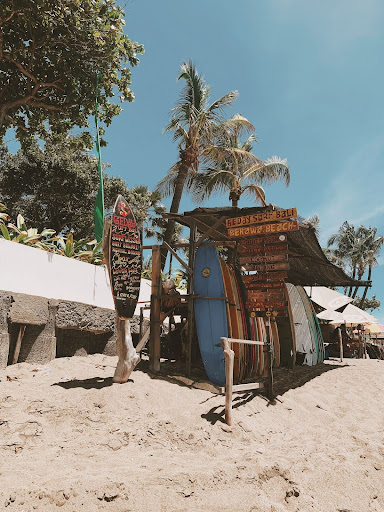
This paradise offers a unique combination of business and leisure opportunities. Bali’s thriving tourism industry makes it an ideal location for bleisure travelers. The island has a wide range of accommodations, from budget-friendly options to high-end luxury resorts. Bali has a strong infrastructure, including a good internet connection, essential for digital nomads. Whether it’s a culinary, cultural, or outdoor experience, Bali is the place for bleisure travelers.
Among the most hype activities travelers can experience are The Ubud Food Festival , The Bali Surf Camp , or The Ubud Monkey Forest .
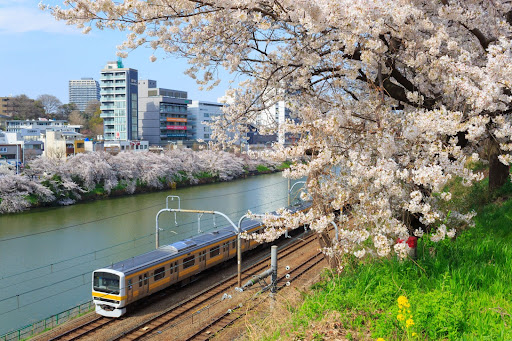
The capital of Japan is a safe and welcoming city with a rich cultural heritage, providing plenty of opportunities for visitors to experience local culture and tradition.
Tokyo Convention & Visitors Bureau , the organization managing destination marketing, constantly looks to create offerings for those seeking to mix business and leisure during their trips.
A top priority is promoting Tokyo as a business & events destination, with many options for the business traveler to find exciting venues, hotels, restaurants, or conference centers. Travelers who plan to visit after work have a wide choice. Whether it’s a list of restaurants with foreign language menus in Tokyo or tour guide services by Tokyo volunteer guides, their mission is to provide the best Tokyo experience for the bleisure traveler.
More and more people combine work and vacation: 76% of business travelers plan some leisure activities during their trips in the upcoming year. This unique audience wants flexible check-in/check-out, fast WiFi, comfortable workspaces, and a variety of local attractions to enjoy after work. Catering to the needs of this unique profile will help your hotel and destination attract more travelers and increase return rates.
- CXP: Customer Experience Platform
- CDP: Customer Data Platform
- Customer Success Stories
- Whitepapers
- Best Practice Guides
- Privacy Policy
- Terms & Conditions

Bleisure travel: Everything you need to know

Connor Avis
23 february 2023, read time: 21 mins, share this post.
It seems that businesses are embracing bleisure travel. And that's great news for business travelers.
It's a perk, benefit, and a great way to motivate travelers that are away on business to go to locations and get the most out of the experience – once the work is done, at least.
For today, we’ll be taking a look at why bleisure travel so effective, why businesses are embracing it and the implications this will have on the corporate travel industry.
What is bleisure travel?
Bleisure travel refers to travel that combines business and leisure activities on a single trip. When traveling somewhere for work, you could set aside some of your free time to sight-see, for example.
It's all in the name, which as you may have guessed, is a portmanteau of the words business and leisure. Also known as 'workations', the purpose of these trips revolves around the business aspect, with the leisure part being more of an addition that is said to have a positive effect on the traveler overall.
This makes sense intuitively, but it's worth looking closer at what counts as bleisure.
The blurring of business and leisure in travel
More than ever, the line between the personal and work lives of employees is becoming blurred. Trends like the rise of virtual meetings , have played a role in that. But now, this is starting to be felt in travel – but in a more positive way.
The experience is not unlike a regular vacation when you step off the plane in a new location. However, you‘ll likely have a strict schedule to keep in order to make it to that exhibition on time and so don’t have time to get to know the location before you are swept away on the next activity on your agenda.
In this context, you can start to see how the concept of business/leisure travel started to appear. People are looking to rebalance the needs of work and leisure while away to get the best of both worlds.
The data backs this up: When corporate travelers were asked about their favorite work-life balance measures, bleisure travel came out on top. [1]
Once you finish that meeting with the client, do you just head straight back to the hotel? What about squeezing in an extra day and flying home on a Saturday or Sunday? If all work has been done, then you would think it would be fine to check out some tourist spots.
That is the essence of bleisure in travel.
Examples of bleisure travel
Looking at things broadly, bleisure can come in numerous different forms. You know that ping pong table at your office? That's one example of combining leisure activities in a business context. The same is true for any other dedicated leisure spaces in the workspace.
The quintessential example of bleisure travel is the business traveler who is flying off to another city to attend a meeting or an event and plans to visit a landmark or two while there.
Here are a few scenarios that would count as an example of bleisure travel:
- A business traveler attending a conference in New York City who extends their trip to spend a few extra days exploring the city's museums, restaurants, and iconic landmarks.
- A salesperson traveling to a client meeting in San Francisco who adds on an extra day to visit nearby wine country and enjoy some wine tasting.
- A consultant traveling to a project site in Bali who takes some time off afterwards to enjoy the island's beaches, temples, and cultural attractions after completing their work.
- A software developer traveling to a tech conference in Tokyo stays the weekend to explore the city's cuisine, fashion, and cultural experiences like a tea ceremony or sumo match.
Then there are freelancers and the wider ‘digital nomad’ community – these people are location independent, allowing them to be more mobile and explore new places in between their work.
You get the idea.
While bleisure has recently risen in prominence, it's not necessarily a new phenomenon – as long as there has been business travel, it stands to reason that some took their free time from their schedule to explore the hotel and surrounding area, too. They didn’t necessarily have time dedicated to leisure, but instead used their evenings to look around.
The difference is that now this kind of combination of leisure and business is now more structured – and is being facilitated by the company.
Why is bleisure travel popular?
Bleisure travel is on the rise. But what makes it so popular?
There are many benefits that the trend can bring about to both travelers and their employees. Here are a few of the headline benefits that can come about:
Benefits of bleisure travel
One of the obvious benefits is how the traveler can get some time dedicated to exploring the location at their own leisure. More importantly, it comes at a reduced cost.
The flights to and from the destination are usually covered by the company as part of the business trip, and so it makes little difference if these flights were moved to the weekend.
In terms of morale though, many people state that it helps prevent burnout from non-stop work and makes them happier. This translates to better quality work.
First up is employee satisfaction in their quality of life. In general, business travel is now seen as a perk, but it seems that when leisure elements are then brought in, the impact is increased.
When asked about their quality of life, those who have bleisure traveled were more likely to be satisfied – about 93% compared to 75% of those who have not done so. [2]
Work/life balance
As mentioned, the rise in bleisure travel comes at a time where the work and personal lives of employees are starting to blur together. Many more people are now working from their homes, bringing work into their personal spaces unlike anything experienced before.
It seems that combining business and leisure when traveling really helped with this. This same report found that these travelers were more satisfied with their work/life balance (87%) against others (64%). [2]
Many businesses are more than accommodating for this, even to the point that they allow business travelers to bring along their family. This is usually at their own cost, though.
Empowerment
Another argument for this is how it empowers traveling employees. It provides them with the ability to independently plan and organize elements of their journey around their desires.
This of course depends how it is implemented in the travel policy, but still goes a long way in handing over some responsibility and independence.
Cultural understanding
The ability to explore a location can also enable more cultural understanding. Travel is a great way to experience local customs and gain a deeper understanding of local culture, which can then be applied to business relationships. That is to say, it helps to strengthen the relationship the travelers have with partners and clients located there.
Sustainability
This is all not to mention the potential reduction of carbon footprint. Sustainability is a big topic right now for businesses but comes at a cost . But, by enabling business travelers to spend time exploring while already there, it makes them less likely to travel there themselves, as they can see many of the sights during the business trip.
This goes hand-in-hand with the fact that business trip itineraries are becoming busier as businesses try to increase the value of each travel and reduce their carbon footprint.
All of this is probably why businesses are so receptive – it increases the satisfaction of employees and looks good on a job description, helping to attract more talent. And that isn’t all.
Potential issues of bleisure travel
Due to the nature of bleisure travel, things can get complicated when it comes to separating the business from the private. Here are a few areas that can be particularly tricky:
Travel policy
Of course, travel policies would need to be reworked to allow for this new dynamic. New rules and guidelines will have to be written up and the boundaries of duty of care will need to be determined.
This means that there is a further need to educate and ensure compliance which could potentially prove to be a problem as travelers enter ‘leisure mode’.
Legal and insurance
This is also important as legal and insurance issues can cause headaches, making these boundaries difficult to define. Ultimately, around 31% of businesses don’t extend their corporate travel risk policy to extra days or leisure time, leaving travelers on the hook. [3]
When traveling abroad, it also becomes more important to double check that the appropriate visa is obtained where needed and that it allows for any activities that are planned for both aspects of the trip.
Likewise, it is important that expenses for business are properly separated from leisure expenses, both for settlement purposes and potentially taxes. The fact is that only 4% of surveyed business travel managers stated that bleisure activities would be covered by their company – outside the inbound and outbound flights. [4]
Another more practical concern for businesses may be the potential data security risks posed by traveling around with business equipment.
It's also worth pointing out that some people don't like the concept of a workation – it can be an odd feeling. In fact, this can really hamper the experience for travelers and make it less enjoyable.
As you can see, there is quite a bit to overcome to make bleisure travel a reality and so businesses need to be on board. Is that likely to happen?
Are businesses on board?
Right from the get-go, it seems that they are indeed on board. Let's take a look at what the statistics say about bleisure travel:
By 2018, 60% of business trips in the US incorporated some sort of leisure component. [5]
We can see the same trend in the EU too. Based on our own data from the German markets, we have found that the share of business trips that started on a weekend – which signifies that some non-work time has been allocated – stood at 15.6% in 2023. This is up from 2019, where the proportion was 12.8%. [6]
This trend looks to grow further too.
One study asked travelers whether they had taken part in bleisure travel in the last year. At 80% and 81% respectively, Baby Boomers and Gen Xers are already well on-board with the movement [2] . This grows to 90% for millennials.
But what’s the point? What incentive do businesses have to offer this? Well, it’s because businesses are gearing up for the fight for skilled workers that is expected to take place.
In another study of ours, it became clear that businesses will be battling it out to attract and retain skilled workers. [7]
Therefore, employee satisfaction will be a major focus in the coming months. Many people regard business travel and more so the opportunity to bleisure travel as a benefit or job perk.
It’s getting easier to combine business and leisure travel
Seeing the changing tides, companies serving the business travel industry have started to cater to this change.
As mentioned, one of the biggest barriers to bleisure travel is the logistics. While employers are more willing to offer employees to enjoy leisure time while out on business, they probably are not so willing to pay for it. This includes things such as hotel and transport.
So, what are companies doing to cater for this?
Mobility as a Service or ‘MaaS’ is a model that is slowly reshaping transport. One of the main hallmarks of MaaS is how it places usability and user-friendliness at the forefront of the experience by making it more accessible in terms of design as well as integrating multiple forms of transport into one place.
Brands are adjusting for bleisure
As you can imagine, this makes it easier to organize business/leisure travel. There are a few examples of some different brands adapting their platforms for this, too.
Avis Car Rental is one such example. It is now offering a bill splitting feature in its mobile app that enables customers to divide payment between corporate and personal credit cards or other forms of payment. [8]
Users are able to split their payments in a number of different ways based on the needs, such as by the total bill amount or by rental days. The cost of vehicle upgrades can also be placed on a second form of payment during a single rental period.
This kind of flexibility makes it much easier to delineate the boundaries between work and leisure time whether an extra day is added or for individual trips.
Marriott is another example. CEO Tony Capuano has made note of this change, with the company adjusting its marketing accordingly. The company will also be adjusting its hotels to fit the bleisure traveler clientele, where the hotel itself becomes part of the destination and where additional services that complement the lifestyle are made available. [9]
As these examples illustrate, the movement of the market is pushing service providers to adapt and reshape their model around business-leisure travel.
Whether that involves making the separation of payments easier or offering services tailored to the bleisure traveler’s needs, more and more companies are coming on board.
The Oktoberfest effect

Every year in late September, Munich welcomes millions of travelers around the globe for Oktoberfest, a festival showcasing Bavarian culture.
What makes it interesting for our topic today is the affect it has on business travel. Munich is the top destination in Germany for business travelers. But during Oktoberfest, the daily rate of airline tickets destined for Munich increases by 50%. [10]
It seems clear that the festival plays a role in this jump, and that the intention for these business travelers is to take part in the festivities.
It is likely that business trips are purposefully planned during the event period as a perk for business travelers who may otherwise not be able to attend. On the other hand, the clients or partners may also enable this as a way of strengthening their relationship with the traveler.
Whatever the reason, this is a fascinating look at how bleisure travel can shape broader travel trends.
Focusing on the employees
If managed properly and accounted for in the planning to some extent, bleisure travel looks to be a very positive change. Sure, there blurring of work and life can be worrisome and cause conflict, but it also offers new opportunities to the travelers.
They can get more out of their travel and go so far as to increase their satisfaction in their quality of life. This means better morale and productivity for the business at little to no extra cost.
It will only get easier too as new solutions come into play that better facilitate the separation of payment for business and leisure, whether that be an extra day at the hotel or a couple extra journeys.
There is even the eco-friendly angle too, as travelers will not need to make a return trip somewhere as they didn’t get to see or do something while out on work there. In any case, this seems to be a manifestation of the more employee-focused outlook businesses are taking.
Subscribe today to our newsletter and get insights like this straight to your inbox.
Banner photo generated by AirPlus
Photo by DocuSign on Unsplash
Photo by Manuel Joseph on Pexels
[1] Preferred work-life balance support measures of business travelers worldwide | Statista
[2] National Car Rental 2019 State of Business Travel Survey Fact Sheet | Nationalcar
[3] Bills, Borders and Bleisure - the fast changing world of business travel | Collinsongroup
[4] Readiness of companies to reimburse for business trips combining leisure activities worldwide | Statista
[5] New Research: Business and Leisure Travel are Becoming Increasingly Blurred | Skift
[6] AirPlus reveals business travel trends for 2023 | AirPlus.com
[7] Companies will continue to rely on remote working | AirPlus.com
[8] Avis courts bleisure travelers with new payment-splitting option | Phocuswire
[9] Marriott Bets on the ‘Bleisure’ Lifestyle | WSJ
[10] Oktoberfest 2023: Bleisure trips on the rise | AirPlus

Related articles

Opportunities
29 May 2024
New Distribution Capability: From distribution to airline retailing
How do you purchase your flights? By going directly to your favorite airline and booking the first flights you see for the dates you need? Or do you search for the best deals on platforms li...

Procurement
28 May 2024
Subscriptions in banking: The payment preference for payment services?
How often do you pay for payment? You probably had to read that sentence at least twice, right? Don’t worry, it’s because you have just entered another dimension in the world of subscription...

Business travel
27 May 2024
11 best practices for a modern corporate travel policy
Embarking on business travels, especially to foreign destinations, can be an intimidating prospect. The unfamiliarity of the surroundings, the need to navigate cultural nuances, and the abse...

How payment data powers business success
They say data is the oil of the digital age. And it’s easy to see why. Data, if used correctly, holds untold savings potential and is a valuable resource for all kinds of businesses. But man...

Travel management
13 May 2024
The Essential Guide to Managing Hotel Spending for Business Travel
Now more than ever, management of travel spend is paramount, and hotel spending represents a significant portion of corporate travel budgets. In fact, for many of our customers, travel is th...

B2B Payments
27 March 2024
The value of online B2B purchases: visible or yet to be unveiled?
It has global reach, it’s cost-effective, and it’s available 24/7. What is it? You guessed it right, it’s the Internet as an online buying channel, in an e-commerce economy that has develope...
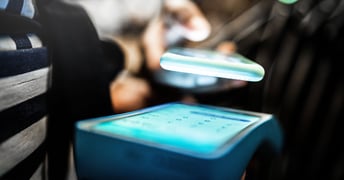
06 March 2024
The ultimate guide to mobile payment
Mobile devices like smartphones, tablets and smart watches – devices carried by billions of people worldwide – are making their way into all factors of life. Whether making purchases, gettin...
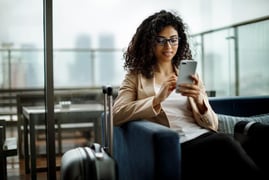
29 February 2024
The digital world is encroaching on the way we travel
The way we travel is changing. We’re always keeping up with the latest business travel trends, and one of the key overarching trends of recent years is how the channels we access and the dev...

21 February 2024
What is long-tail spend management and why does it matter?
Spend management is vital for businesses. The ability to oversee spending, manage cash flow, and ultimately maximize the value of each purchase can lead to significant savings in both time a...

29 January 2024
5 reasons why rail travel is trending for business trips
Let’s say you have a meeting. You’re currently in Amsterdam, but your meeting is with a potential partner in Paris. Between the two cities there’s a total distance of 507km. So how do you ch...
Subscribe now
Matador Original Series
Bleisure is the next biggest trend in travel, and it’s redefining the work-life balance.
“Business or leisure?” It’s a question that’s been asked a million times at hotel check-in desks, car rentals, and airline ticket counters all over the US and the world: “Are you traveling for business or leisure?” Fun or work? Now there’s a new answer: bleisure.
What is bleisure?
Otherwise known as a “bizcation” or “workcation,” bleisure travel is a growing trend where business travelers tack on a few extra days at the beginning or end of a business trip for some “me time.” These extra days can be used to explore the destination more, relax and recharge , or just have a slow day or two to catch up on work.
Why is bleisure becoming so popular?
While in the past bosses might have frowned on this (and employees were unsure of policy and too afraid to ask), over the past few years there’s been a shift in communication with boss and employee being on the same page regarding a bleisure extension.
There are several reasons bleisure travel is starting to take off. First is the type of travelers making these trips: millennials. Growing in power and numbers in the workforce, the millennial generation is traveling more for business and going on more business trips than past generations, taking an average of 7.4 trips a year.
This feeds into the second reason, which is a better work-life balance, something that millennials have expressly prioritized regarding when and where they work. Millennial employees want to be seen and appreciated as valued members of a company, not replaceable cogs, so they apply to and work at companies that treat them as such, allowing them to balance work and their personal lives.
“The rise in bleisure travel correlates with the fact that more and more people want to create a better work-life balance for themselves,” says Hertz vice president of travel distribution sales Maurice Honor.
Employers have been grappling with this new workforce trend and, eager to retain personnel, are opening up to ideas and policies like bleisure as it prevents burnout and promotes loyalty — a happy employee is a better asset to the company overall, with increased productivity and a greater likelihood of staying at the company for the long-term. So if that calls for a few extra days of some off-time here and there (especially given that, as the first generation to enter the workforce with technology and the internet, millennials are constantly tuned in anyway) then companies are getting on board and adding bleisure policies, which vary from company to company on details like hotel stays, what can be discounted as a business expense, length of extension, etc.
And it’s not just hip start-ups full of young people that are incorporating bleisure: major corporations are taking notice, with influential players in the business travel markets like AMEX Global Business Travel writing and sharing blog posts and articles detailing the many benefits of allowing employees to take bleisure time. Top travel companies like Expedia have also been running studies on bleisure travel to demonstrate its benefits and scope.
How does bleisure work practically?
“But wait. Won’t the employee still have to pay for their own hotel for the extra nights, as well as meals and stuff? If they’re in a major city, that won’t be cheap!”
True, adding a bleisure day or two will be on the travelers’ own dime . But they can still take advantage of some of the many perks of business travel that will reduce costs, like asking to use the company’s lodging rate at the hotel. A lodging rate is a reduced per-night fee negotiated between the hotel and the company that can save major bucks, and many companies are already implementing this into their bleisure policies for jet-setting employees to use.
Bleisure has already made itself at home in the US, with top domestic destinations like Seattle , Denver , Atlanta , and more. Smaller cities like Minneapolis or Tampa that may not otherwise receive huge tourist numbers, but do see a lot of business people, can also be appealing for a long weekend. While there may not seem like a ton to do, a craft brewery or trendy food hall is usually never far away, and personal trip expenses can be kept very low.
Adding a bleisure addition to international trips is also on the rise, with 80 percent of business trips abroad having been extended. With the company footing the bill for that international flight to Tokyo , one of the leading international bleisure destinations, why not?
A version of this article was previously published on September 4, 2019, and was updated on February 3, 2022.
More like this
Trending now, 19 epic airbnbs in montreal for a bachelorette weekend, the perfect las vegas airbnbs for an unforgettable bachelorette party, the coolest airbnbs in scottsdale for a golf-themed bachelor party, the most gorgeous airbnbs for your tulum bachelorette party, 14 amazing airbnbs for your jackson hole bachelorette party, discover matador, adventure travel, train travel, national parks, beaches and islands, ski and snow.
We use cookies for analytics tracking and advertising from our partners.
For more information read our privacy policy .
Matador's Newsletter
Subscribe for exclusive city guides, travel videos, trip giveaways and more!
You've been signed up!
Follow us on social media.
The Rise of Bleisure Travel and How to Make the Most of it
Table of Content
What is bleisure, who are bleisure travelers, reaching bleisure travelers, adjusting your offers for bleisure travel.
Over the last few years, there’s been a growing trend around business travel. People are starting to mix their work trips with leisure, also known as bleisure travel.
This trend presents a new opportunity for tour and activity providers. The growing bleisure segment largely consists of both millennials and more experienced travelers. Both groups have their own purchasing habits, different from the typical tourist.
By reaching them at the right place and time with special offers, you gain an advantage over competitors. In addition, the opportunity to boost your referrals and positive reviews online can have a long-term impact on your business.
In this post, we’ll suggest the best ways to reach bleisure travelers and tailor your deals for them. But first, we need to look at what exactly bleisure is and what characterizes bleisure travelers. This way, we’ll get a better understanding of the trend.
Ready? Let’s dive in.
Bleisure is a mix between “business” and “leisure”. It means combining work trips with fun activities while abroad. In simple terms, bleisure mixes business travel with entertainment.
This travel style is getting more common according to studies. Consider this data quoted by Forbes:
- 78% of millennials intentionally add personal time on a business trip ( source: Chase )
- 57% of companies have a policy for young employees to extend business trips with vacation time ( source: AMEX Global Business Travel )
- 74% of frequent business travelers wish their corporate travel policy included a budget for entertainment ( source: Swapnil Shinde, Co-Founder and CEO of Mezi )
And while normal business trips last 2 days on average, bleisure travels can often be 6 days long or more .
Not only do the stats back it up, but many companies see considerable effects from bleisure travel on their bottom line. For example, travel agency CheapOair reports over 20% annual revenue growth in bleisure travel for the last 3 years straight .
There are many reasons bleisure travel is on the rise. To start with, it’s beneficial for employee satisfaction and it costs next to nothing for employers. Tickets are often cheaper when you stay over Saturday. This means companies don’t spend much extra while improving staff morale and attracting better talent. In fact, Booking.com suggests that 30% of people would accept a job with a lower salary if it offers more business trips .
Aside from offering cheaper plane tickets, airlines, and travel agents encourage bleisure through their sales and marketing. This is no surprise – they also get extra revenue through referral fees and longer stays.
In addition, more and more companies are ditching the office and work remotely, making it easier to work and travel for fun at the same time. This is magnified by freelancers and indie entrepreneurs who travel almost full-time, also known as “digital nomads”.
If that’s not enough to prove bleisure is a thing, consider apparel startup Par en Par which creates clothing specifically for bleisure travelers.
According to the CWT survey , bleisure travel is common among millennials aged 25-34. However, the second largest group are middle managers aged 36-54 with average annual incomes close to $80,000. They most often come from the tech industry and represent a lucrative segment overall.
Sometimes it could be a full team retreat where all employees in a company meet in a single location for a few days or weeks of work and fun. Bleisure travelers are typically male, with a US study suggesting that men take more work-related trips (70% male vs 30% female). For a full profile of bleisure travelers, you can also check out this research summary by Altexsoft .
As you can see, bleisure presents a new, lucrative, and growing market segment to target. Considering bleisure travelers in your offerings and marketing communication can give you an advantage over competitors. Not just in terms of revenue, but also valuable referrals and online reviews leading to a long-term benefit for your business.
So how do you capitalize on this opportunity? By knowing who bleisure travelers are and what they want, you can reach them at the right time and place with high-value, tailor-made offers. Following are some of the best ways to target bleisure travelers based on their profile and purchasing habits.
Travel agents and related businesses
You can advertise on travel agent networks so bleisure travelers see your offer while booking a trip. You can also partner up with related businesses like co-working spaces, transport, and even restaurants. This way you can delight your bleisure customers while getting referrals and new business relationships.
Did you know Regiondo partners with 150+ travel agents so you can get your offer in front of millions of people each month? Try our booking software for free and see what you can achieve with such a vast distribution network.

Content marketing
You can also create special content offers for bleisure travelers. What are the things they need to know about your city? What are the best places to stay? The coffeeshops with the fastest wi-fi? The most convenient office spaces? If you pop-up in Google while they do their research, it’s more likely that they’ll try your tour or activity and even get on your email list. This leads to the next good way to reach bleisure travelers:
Email newsletters
If you do your research well, you can find a number of companies with dedicated bleisure policies for their employees. You might even find out if they have a client in your location that they visit often. This is especially relevant if you’re based in a large financial or business center. Find out which companies allow and encourage their employees to mix business trips with some fun. Then offer them a special newsletter with discounted packages. You might just get a spotlight feature every time someone in the company is coming your way.
Networking events
You can also stay on top of relevant networking events and promote them in exchange for a mention as a sponsor. And if you have the capacity, why not organize an event yourself? This way you can raise awareness among both local businesses and international travelers.
If you’re in a location that’s popular with digital nomads, you can create a special event that can result in substantial referrals later. There are many digital nomad online groups where people exchange recommendations for places around the world.
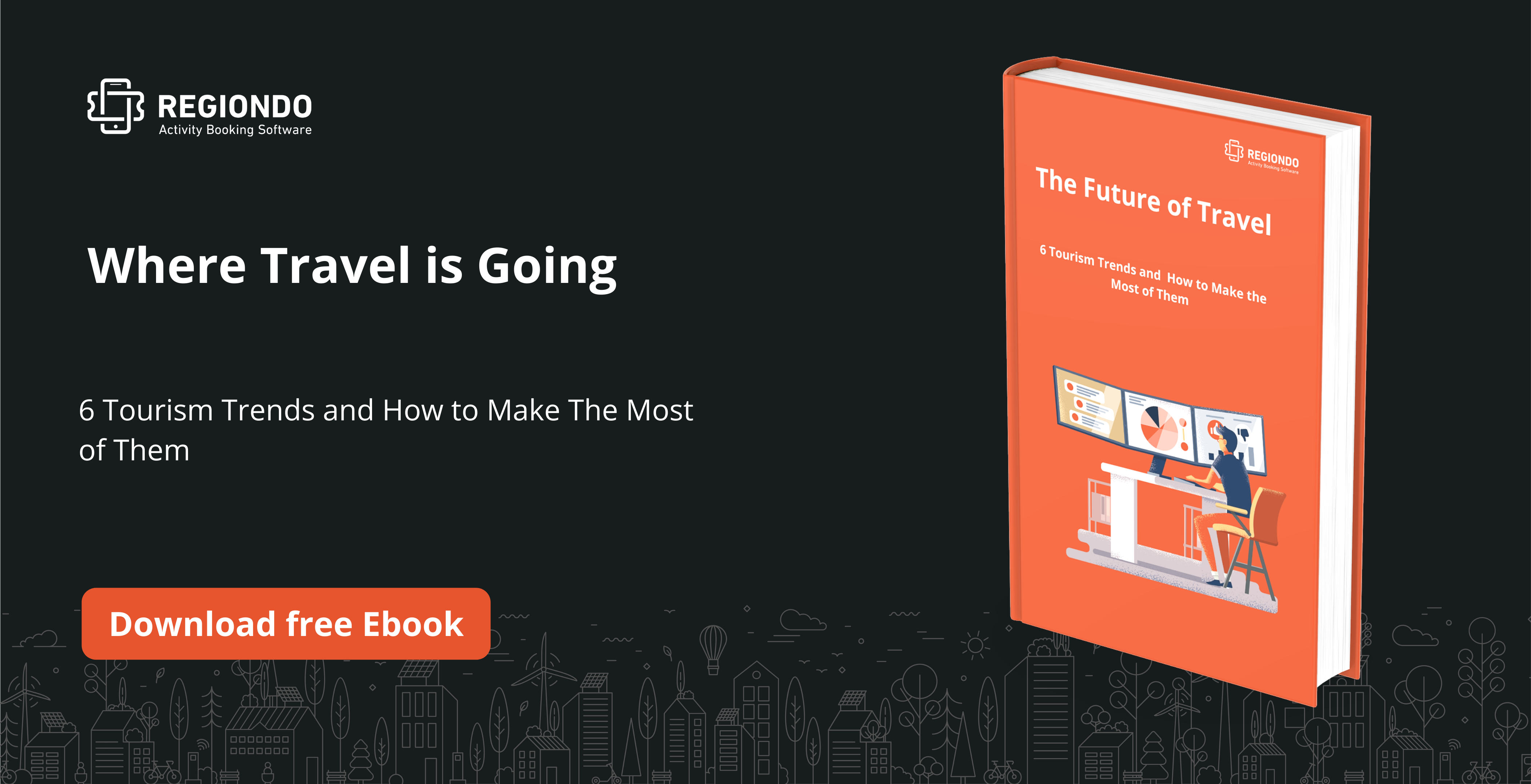
Partnerships
You can also partner up with some loyalty programs, even credit cards if you’re lucky. Frequent travelers will often amass points so they might as well spend them on your tour or activity.
Highly targeted advertising
You can advertise on specialized blogs for bleisure, such as the Tagalong Traveler . Other channels are Facebook and especially LinkedIn, which allows you to reach people with specific job titles. Professional groups and forums online can also be a good way to get your tour or activity in front of a relevant bleisure audience.
Now that you know how to reach bleisure travelers, what are the offers that they are most receptive to?
Special discounts
Being millennials and digital nomads , bleisure travelers are often price sensitive. Adding juicy discounts and coupons can be a great way to entice them to come along and try out what you have to offer. If you’ve already set up your online shop with Regiondo, here’s a guide to creating your first discount code .
Group packages and +1 offers
The more experienced group of bleisure travelers often bring a partner or even their whole family along. For them, as well as for team retreats, it’s a good idea to set up fun group packages that come with perks like transportation, photos, and videos. Many corporations will appreciate the ability to share photos and videos of their fun retreat on their social channels – hassle free. This might even get you a few backlinks and social mentions!
Back to the basics
Of course, you also need to get the basics right which is valid for non-business travelers as well. Things like having your website and offers translated in major languages or at least English , as well as providing easy travel instructions are a must.
While bleisure travel is relatively new, it seems like it’s here to stay. The data and research so far indicate that the segment is growing and represents a good opportunity for tour and activity providers. As long as you reach bleisure travelers at the right time and place with the right offers, you should get a strong advantage and long-term profits from it.
You might also like:
- Travel Like a Local: How Tour Operators Can Make the Most of This Trend
- Health Tourism in the EU: Facts and Figures
- Virtual Reality in Travel: 9 Applications for Tours, Destinations & Activities
- 9 Tourism Trends That Will Shape the Travel Industry in 2020 and Beyond
- The Rise of Solo Travel and How to Make the Most of it
- When Numbers Matter: The Travel Statistics You Need to Know About
- The Rise of Experience Tourism and What It Means for the Leisure Industry
Related Articles

Stay updated with Regiondo by signing up for our Newsletter

Get a personalized demo or create your free account now
Take your business to the next level with Regiondo - it's free to get started and you don't need a credit card.
- Travel, Tourism & Hospitality ›
Business Travel
Bleisure travel - statistics & facts
Is bleisure a new type of travel, what motivates bleisure travelers the most, key insights.
Detailed statistics
Global bleisure travel market size forecast 2023-2033
Popularity of business trips with a weekend stay worldwide 2019-2022
Change in interest in bleisure travel by global corporate travel managers 2023
Editor’s Picks Current statistics on this topic
Current statistics on this topic.
Business Travel Spending
Global spending on bleisure trips 2021-2027
Plans for work-related trips worldwide 2023, by type and country
Opinions on blended trips and flexible work worldwide 2022
Related topics
Work trends.
- Coworking spaces
- Hybrid work
- Digital nomads
Travel trends
- Sustainable tourism worldwide
- Space tourism
- Mobile travel trends
Tech & work
- Artificial intelligence (AI) in labor and productivity
- Cybersecurity
- Open source software
Recommended statistics
- Premium Statistic Global bleisure travel market size forecast 2023-2033
- Premium Statistic Global spending on bleisure trips 2021-2027
- Premium Statistic Prospects of global corporate travelers on going on bleisure trips 2022
- Premium Statistic Change in interest in bleisure travel by global corporate travel managers 2023
- Premium Statistic Countries with highest increase in interest in bleisure trips 2022
- Premium Statistic Major reasons to take bleisure trips for U.S. business travelers 2022
Forecast value of the bleisure tourism market worldwide in 2023 and 2033 (in billion U.S. dollars)
Expenditure of travelers combining business with leisure worldwide in 2021, with a forecast for 2027 (in billion U.S. dollars)
Prospects of global corporate travelers on going on bleisure trips 2022
Likelihood of mixing business trips with leisure trips according to business travelers worldwide as of March 2022
Increase in interest of employees in combining business trips with leisure activities according to business travel buyers worldwide as of October 2023
Countries with highest increase in interest in bleisure trips 2022
Countries with highest annual percentage change in willingness to extend work trips to experience a destination using time off in 2023 as of August 2022
Major reasons to take bleisure trips for U.S. business travelers 2022
Main motivating factors to combine business with leisure trips for corporate travelers in the United States as of February 2022
Bleisure trips
- Premium Statistic Popular tourist activities worldwide 2023
- Premium Statistic Popularity of business trips with a weekend stay worldwide 2019-2022
- Premium Statistic Bleisure travel plans worldwide 2022
- Premium Statistic Popularity of work-related trips worldwide 2022, by type and country
- Premium Statistic Plans for work-related trips worldwide 2023, by type and country
- Premium Statistic Work-related travel plans worldwide 2023, by type and country
Popular tourist activities worldwide 2023
Most common travel-related activities worldwide in 2022
Share of business trips that contained a weekend worldwide from 2019 to 2022
Bleisure travel plans worldwide 2022
Share of respondents who planned blended trips worldwide as of 2022, by type
Popularity of work-related trips worldwide 2022, by type and country
Share of respondents from selected countries who took work-related trips worldwide in 2022, by type
Share of respondents from selected countries who planned to take work-related trips worldwide in 2023, by type
Work-related travel plans worldwide 2023, by type and country
Share of respondents from selected countries who planned to take work-related trips in 2023, by type
Bleisure travelers
- Premium Statistic Global business travelers taking leisure time at their destinations 2022
- Premium Statistic Workation intentions worldwide 2023, by destination type
- Premium Statistic Workation intentions worldwide 2023, by country
- Premium Statistic Workation plans worldwide 2023, by country or region
- Premium Statistic Share of Europeans that want to work from global summer holiday locations 2022-2023
- Premium Statistic Affluent consumers expecting to take a vacation worldwide H2 2022, by type
- Premium Statistic Share of U.S. business travelers 2022, by trip type
Global business travelers taking leisure time at their destinations 2022
Share of travelers who explore business destinations as tourists worldwide as of February 2022
Workation intentions worldwide 2023, by destination type
Share of respondents who intended to work from a holiday location worldwide in summer 2023, by type of destination
Workation intentions worldwide 2023, by country
Share of respondents who intended to work from a holiday location worldwide in summer 2023, by country
Workation plans worldwide 2023, by country or region
Travel plans of respondents who intended to work from a holiday location worldwide in summer 2023, by country or region
Share of Europeans that want to work from global summer holiday locations 2022-2023
Share of European respondents who intended to work from a holiday location worldwide in summer 2022 and 2023
Affluent consumers expecting to take a vacation worldwide H2 2022, by type
Share of affluent consumers that expected to take a holiday within the next year in selected regions worldwide as of 2nd half 2022, by type of vacation
Share of U.S. business travelers 2022, by trip type
Share of respondents from the United States who anticipated traveling for work as of 2022, by trip type
Travelers' behavior
- Premium Statistic Opinions on blended trips and flexible work worldwide 2022
- Premium Statistic Favorite work-life balance measures of corporate travelers worldwide 2022
- Premium Statistic Favorite lodging types for workations worldwide 2023, by region or country
- Premium Statistic Most important features at accommodations for U.S. bleisure travelers 2022
- Premium Statistic Favorite trip length for U.S. bleisure travelers 2022
Attitudes towards business trips combed with leisure worldwide for 2023 as of August 2022
Favorite work-life balance measures of corporate travelers worldwide 2022
Preferred work-life balance support measures of business travelers worldwide as of March 2022
Favorite lodging types for workations worldwide 2023, by region or country
Preferred accommodations for a workation trip in selected countries worldwide for summer 2023
Most important features at accommodations for U.S. bleisure travelers 2022
Preferred accommodation amenities for bleisure tourists in the United States as of February 2022, by utility score
Favorite trip length for U.S. bleisure travelers 2022
Preferred length of stay for trips combining business with leisure activities in the United States as of February 2022
Companies' perspective
- Premium Statistic Work-life balance measures offered to corporate travelers worldwide 2022
- Premium Statistic Support of employers for blended trips worldwide 2022
- Premium Statistic Companies' policies on bleisure travel reimbursement worldwide 2022
- Premium Statistic Corporate travel perks offered by companies in U.S. and Canada 2023
- Premium Statistic Expenses distribution of blended trips in the U.S. 2022
Work-life balance measures offered to corporate travelers worldwide 2022
Work-life balance support measures offered to business travelers worldwide as of March 2022
Support of employers for blended trips worldwide 2022
Support for bleisure trips from organizations worldwide as of August 2022, by employee type
Companies' policies on bleisure travel reimbursement worldwide 2022
Readiness of companies to reimburse for business trips combining leisure activities worldwide as of September 2022
Corporate travel perks offered by companies in U.S. and Canada 2023
Most common benefits that companies would consider providing to business travelers in North America as of 2023
Expenses distribution of blended trips in the U.S. 2022
Cost sharing for bleisure travel plans of adults in the United States as of August 2022
Further reports Get the best reports to understand your industry
Get the best reports to understand your industry.
- Global business travel
- Business travel in the United States
- Work from home: remote & hybrid work
- Remote work in the U.S.
Mon - Fri, 9am - 6pm (EST)
Mon - Fri, 9am - 5pm (SGT)
Mon - Fri, 10:00am - 6:00pm (JST)
Mon - Fri, 9:30am - 5pm (GMT)
Be Better Blog
Strategy & Insights
Attracting Bleisure Travelers
By Hayley Corbett
May 11, 2023
Technology has been blurring the lines between work, leisure and regular home life since long before COVID-19.
Professionals worldwide have been seizing the opportunity to extend their work trips by adding weekends or even entire weeks to their stays for ages. Whether flying solo, with a partner or tagging along with the family, the fusion of business and leisure travel is so well-established that it has a catchy nickname – Bleisure.
An amazing portmanteau that describes the practice of combining business travel and leisure travel into one trip, bleisure is not a new trend. Expedia’s 2018 Bleisure Travel Report showed that 60% of business travelers would extend their work trips for a little R&R.
Fast forward to 2023, and Expedia Group’s 2023 Traveler Value Index indicates 76% of business travelers are planning a bleisure trip in the next 12 months.
For destination management organizations (DMOs), embracing the travel and tourism marketing trend necessitates understanding what the future of business travel looks like and how to engage bleisure travelers.
The Return of Business Travel
We’re witnessing a resurgence of business travel in 2023 as it inches closer back to pre-pandemic levels. But two studies found that while the metrics are returning, behaviors are shifting.
According to a study by Deloitte in April 2023, the corporate travel industry is expected to fully bounce back to 2019 levels by late 2024. Their findings found that the travel industry is in the midst of a significant transformation, spurred by social and corporate shifts.
As more folks embrace remote work and seek flexibility, there’s an increased expectation for adaptable travel bookings. They suggest that companies are rethinking their strategic positioning of travel , placing greater emphasis on technology like conferencing platforms to replace traditional travel use cases.
Expedia Group’s 2023 Traveler Value Index shows that roughly a third of consumers plan to embark on a business trip in the next year. This is a major leap from April 2022, when a mere 16% of consumers said they’d travel for business within the next year! In Q3 of 2022, Expedia Group’s first-party data revealed a 10% increase in demand from travelers with a business profile, further indicating a rise in business travel. Expedia also found that “alternative business travel” is gaining traction, with “bleisure” travel and “flexcations” adding a whole new dimension to demand.
Flexcations, a delightful blend of remote work and leisure travel, are also on the rise, with 28% of consumers planning to flex their work options and take a flexcation in the next year.
What Is Bleisure Travel?
Bleisure travel is about opportunity. It enables travelers to extend their work trips to further explore destinations for fun. Bleisure travelers squeeze in a few extra days or even a weekend to relax and immerse themselves in the local scene.
Business might bring the visitor to the destination, but exploring passions is a personal pursuit. For example:
- Attending a trade show in a new city and staying a few extra days to explore local hiking trails.
- Going on a business trip with a partner or family member and turning it into a quiet vacation.
- Adding an extra weekend to a conference to attend a music festival.
- Making a sales call and spending an extra day taking a food or wine tour in the area.
- Going on a business trip to a ski resort and adding a few days to hit the slopes.
- Combining a trip to a manufacturer in a foreign country with language classes and cultural tours.
What Motivates Bleisure Travel?
Bleisure travel owes its popularity, in part, to the increased number of remote workers enjoying more flexible schedules. This flexibility has opened up new possibilities to experience a destination beyond their work commitments. The rise of technology has made it easier for remote workers to stay connected with their colleagues and clients while on the go, too, making it more feasible to extend their stay for leisure activities.
- Personal Enrichment: Bleisure travel enables professionals to immerse themselves in new cultures, cuisines, and experiences, leading to personal growth and a broader world perspective.
- Recharging and Inspiration: Exploring a destination after a work commitment provides an opportunity to recharge, destress, and return to work refreshed, inspired, and ready to tackle new challenges.
- Bucket List Adventures: Bleisure travel helps globetrotters cross off must-visit locations on their bucket lists, seizing the opportunity to visit dream destinations while fulfilling work responsibilities.
- Work-Life Balance: Bleisure travelers seek a harmonious blend of work and play, helping them unwind after meetings while experiencing the local culture and attractions.
- Cost Savings: Combining business and leisure travel can be more cost-effective, as companies often cover transportation and accommodation expenses for the work portion of the trip.
- Family Time: Including family members or significant others in bleisure trips allows travelers to share new experiences with loved ones, strengthening bonds and creating cherished memories.
But it’s not just the bleisure traveler who is benefitting.
Employers can use bleisure travel as a strategy to retain top talent by combining work and personal interests, leading to happier, more productive employees. This strategy not only provides employees with a break from the daily grind of work but also allows them to explore new destinations, cultures and experiences while building stronger relationships with colleagues and clients.
For destinations, bleisure travel can be a lucrative opportunity, attracting travelers who might not have visited otherwise to extend their trips and explore the surroundings. This can result in increased revenue for hotels, restaurants and local attractions. By embracing and catering to the bleisure traveler, destinations can create a memorable experience that encourages visitors to return and even recommend their destination to others.
Characteristics of a Bleisure Traveler
Bleisure travelers, a unique breed of explorers blending business and leisure, are increasingly making waves in the world of travel. Let’s dive into the fascinating world of these globetrotters and uncover what makes them tick.
- Adaptable: Bleisure travelers easily adjust to new environments and work-leisure schedules.
- Cost-conscious: They seek cost-effective solutions, maximizing value from their combined trips.
- Time-efficient: These travelers plan to make the most of their limited time in a destination.
- Tech-savvy: They utilize technology to stay connected with work and plan leisure activities.
- Organized: Bleisure travelers often plan their schedules meticulously to balance work and play.
- Open-minded: They’re receptive to exploring new cultures, cuisines, and experiences.
- Social: Networking and forging connections with locals and professionals are important to them.
- Curious: A sense of curiosity drives them to discover and learn about the places they visit.
- Brand-aware: Bleisure travelers are mindful of their preferred brands for accommodation and services.
- Environmentally conscious: They may seek eco-friendly travel options to minimize their footprint.
- Health-focused: Prioritizing well-being, they may opt for accommodations with fitness facilities or wellness programs.
- Experience-seekers: They’re drawn to unique and memorable experiences while exploring new destinations.
- Independent: Bleisure travelers often enjoy the freedom to design their own itineraries.
- Safety-conscious: They prioritize safety and security in their travel choices and accommodations.
- Family-oriented: When possible, they may include family members or significant others in their trips.
- Trend-savvy: Bleisure travelers stay informed about the latest travel trends and innovations.
- Loyal: They may show loyalty to specific airlines, hotels, or travel providers that cater to their needs.
- Culturally sensitive: These travelers make an effort to respect and understand local customs and traditions.
- Opportunistic: WIFM. Taking advantage of a business travel opportunity for personal pleasure is at the core of the bleisure travel experience.
- Goal-oriented: Bleisure travelers have clear objectives for both the business and leisure portions of their trips.
- Review-driven: They often rely on reviews and recommendations to make informed decisions about accommodations and experiences.
How to Encourage Bleisure Travel
When it comes to bleisure travel, there’s a need for specific messaging and promotions to appeal. Let’s break down some areas to explore to incentivize travelers to extend their work trips into workcations.
Extended Stay Promotions
Destinations can encourage bleisure travel by offering special deals and packages. For example, offering discounts on extra nights or local events can entice business travelers to extend their trip and explore the destination.
Destinations can also create specific bleisure packages that include tours or tickets to local attractions. By promoting these offers, destinations can attract more bleisure travelers and increase revenue from extended stays.
Example: For example, when a large convention comes to town, partner with the meeting planner to offer a special extend-your-trip promotion for the attendees that gives them a discounted hotel room for an additional night(s) plus tickets to a local attraction or sporting event for them and their family.
Provide the Right Amenities
Business travelers—whether coming to meet with clients or to attend a large convention—need access to well-maintained workspaces with dependable internet access, while leisure travelers are looking for spas, fitness centers, and pools. They’re not unlike digital nomads in that way.
Destinations should highlight their unique business-centric amenities like desks in the hotel room, and show how they meet the needs of both types of travelers. By offering the best of both worlds, destinations can attract more bleisure travelers and create a more enjoyable travel experience for them.
Example : On your DMO website, consider new ways to feature hotel amenities front and center on listing pages, or perhaps create a badge program for hotels that qualify as the most business-friendly stays to make it easy for travelers to identify the options with the best business and leisure amenities.
Provide Inspiration Through Content
Destinations should highlight the diversity of leisure activities available to attract bleisure travelers. This could include blogs or social media posts about outdoor recreation, cultural events, or local attractions available outside 9-to-5 work hours. There are also opportunities to create meeting-specific content that appeals to meeting and convention attendees to understand how far their business is from major area attractions.
For example, when we redesigned the Santa Monica Meetings website, it was important to show the distance from markers such as Downtown LA and Disneyland. And who wouldn’t want to bring their family and take them to Disneyland on their bleisure trip? By showcasing these activities, destinations can appeal to bleisure travelers and create a more engaging travel experience.
Example : Write bleisure-specific itineraries highlighting reasons to extend a stay into the weekend, workspaces and coffee shops with wifi, happy hours, drop-in fitness classes and more.
Find Opportunities to Inspire Return Travel
Let’s be honest. Not every business traveler has the ability to extend their stay or bring their family with them on a work trip. But that doesn’t mean we lose the opportunity to have them see the leisure side of a destination!
DMOs can look for opportunities to incentivize return travel—whether that’s simply finding ways to encourage email sign-ups for your newsletter lists at meetings and conventions so you can stay in touch or creating a custom offer for individuals that are in town for that meeting, so they look forward to returning.
Example : Create a custom email segment, allowing people to self-select as a “business traveler” when they subscribe. Send custom emails to that list inspiring them to come back and providing itineraries and inspiration specific to them.
Live the Life of Bleisure
Professionals worldwide are seizing the chance to mix business with pleasure, extending work trips by a few days or even a week to their stays. Solo adventurers, couples and families alike are embracing this unique blend of business and leisure travel. Destinations and businesses that cater to this trend can capitalize can inspire longer stays, more midweek nights in market and return visitation.
Not sure where to start your bleisure journey? Contact Noble Studios and let us help you develop a creative digital performance marketing approach to showcase your destination’s bleisurability.
Hayley Corbett
Associate Director, Client Experience
Join us in celebrating National Travel and Tourism Week 2023! Discover the impact of the travel industry on our communit…
Subscribe to Our Newsletter
Let's Be Better Every Day
What is Looker Studios? It's more than just the new name for Google Data Studio. Looker Studio is a self-serve business …
Google released the April 2023 reviews update at 9:08 PDT on April 12, 2023. This algorithm update is aimed at ensuring …
Help your business show up in a local 3-pack with these 11 Google Business Profile (GBP) optimizations & best practices.…
Chinese travelers no longer face stiff travel restrictions. Discover the resurgence of Chinese tourism in the US, learn …
Valuable Personal Relevant Experiences (VPREs) are digital experiences that mean something to people because they are va…
Resilient strategic marketing in a recession is possible. Emphasizing conversions, revenue and market share gains is imp…
Google's March 2023 core algorithm update has begun rolling out and will impact all websites, regardless of size or nich…
The 2023 Visit California Outlook Forum brought together travel and tourism marketing industry experts, leaders, partner…

- Thought Leadership
- Wamda Capital
- Partner projects
AI redefines MENA corporate travel business
Thought Leadership • 24 June, 2024

An article by Stan Klyuy, a Chief Commercial Officer at Tumodo, an online business travel platform.
In 2024, the digital transformation of business travel has become our reality, with artificial intelligence (AI) leading the charge in travel management programs, making it more straightforward and efficient. This surge in AI adoption is part of a global trend, with the Middle East and North Africa (MENA) market for AI in travel expected to reach $423.7 billion by 2027, growing at a CAGR of 35% between 2022 and 2027.
Beyond efficiency, AI is making travel more personalised with its ability to tailor flights, hotels, and transportation according to travellers’ preferences, driving significant revenue for the industry. In fact, AI is improving travel and expense compliance, with research suggesting that compliance could be improved by as much as 70%.
Here, we'll explore key industry trends, offer some insights into how corporate travel has changed in the last year, and highlight the fascinating potential of artificial intelligence to transform business travel in the future.
The Evolution of Business Travel Management through AI
Let’s face it – AI has transformed how we approach corporate travel, from planning and booking to managing the entire trip. In particular, cutting-edge tools empower companies to optimise operational costs, streamline procurement processes, and enhance employee travel experiences.
These advancements foster collaboration across departments – finance, human resources, and travel management teams – all working towards shared goals, such as developing effective travel policies and aligning travel initiatives with the corporation's strategic vision. But this is just the tip of the iceberg.
AI has become essential for companies to grasp employee travel preferences and deliver highly personalised experiences. It also provides up-to-date information on flights, hotel check-ins, and other crucial aspects of business travel. For instance, AI facilitates data-driven decision-making by offering insights into travel patterns, spending habits, and potential cost-saving opportunities. This aligns perfectly with the evolving landscape of travel management companies, which increasingly prioritise digital-first approaches, sustainability initiatives, and flexible business options.
Specifically, the MENA region demonstrates rapid AI adoption in business travel. Dubai is piloting AI for baggage handling, air traffic management, and immigration processes, while in Abu Dhabi, Etihad partnered with Microsoft to launch an AI Academy to fast-track employee-driven business ideas. At the same time, Chatlyn, a leading travel and hospitality guest experience software developer, showcased its advanced AI chatbot at the Arabian Travel Market 2024 that ensures accurate, real-time responses, enhancing communication for hotels with a diverse clientele and significantly improving response times.
Furthermore, AI-powered tools enhance travel safety and security. Real-time detection of suspicious activities allows for safer travel experiences. Dubai's reputation as a safe and welcoming tourist destination with strict safety regulations further exemplifies the potential of AI to elevate travel safety within the MENA region. For example, AI is revolutionising airport security through automated threat analysis and identification to enhance security measures and improve processing speed and accuracy.
AI also contributes to sustainability in business travel by optimising travel routes and reducing unnecessary trips. It offers deep insights into a company's carbon footprint, leading to swift cost-cutting opportunities. For instance, by analysing travel data, TumodoGreen's AI analytics calculate carbon footprints and suggest the most eco-friendly routes. According to BCG, applying AI to all emissions could achieve 5% to 10% reductions, equivalent to 2.6 to 5.3 gigatons of CO2.
Personalisation and Customer Experience in Corporate Travel
Personalisation has emerged as a critical differentiator in today's corporate travel landscape, driven by services that consider cultural nuances, navigate complex regulations, and tailor logistics to a company's specific business objectives. This shift reflects a growing reality – over 74% of business travellers prioritise the overall experience over mere cost savings.
Take, for example, Tumodo, which leverages AI to analyse vast travel data within the MENA region. By uncovering hidden patterns and trends, like the growing popularity of "bleisure" trips, Tumodo's AI algorithms identify optimisation opportunities, translating to significant cost savings (up to 35%) and an enhanced overall customer experience.
AI's power goes beyond cost savings. It analyses a wealth of data – travel history, behaviour patterns, and even social media interactions – to personalise the travel experience for each individual. This not only saves travellers time and effort but also streamlines the entire planning process. However, AI personalisation is not limited to the destination. For example, AI tools can recommend activities tailored to individual preferences, suggesting dining options, sightseeing attractions, and more. This ensures every traveller has a fulfilling experience that aligns with their interests.
The impact of AI extends further, enhancing customer experience at every touchpoint of corporate travel. AI is present throughout the journey, from pre-trip planning and booking to in-destination activities and post-trip support, including preferred airlines and hotels, to dietary restrictions and leisure activities.
The Future of AI in Corporate Travel
The future of AI in corporate travel is brimming with exciting possibilities. Research by Skift indicates that hospitality leaders overwhelmingly believe in the benefits of Gen AI tools: 81% see them as advantageous, with 52% prioritising their development. Additionally, 95% are confident these advancements will significantly enhance guest experiences. This aligns with a McKinsey report suggesting AI's potential to unlock substantial value – as much as $150 billion – in the Middle East's GCC countries, representing a significant portion (9% or more) of their combined GDP.
The message is clear: AI in corporate travel is poised for continuous evolution. One key development to anticipate is the rise of AI-powered travel companions. These virtual assistants will be available 24/7 to answer questions, provide location-specific recommendations based on your preferences, and seamlessly translate information across languages, overcoming traditional language barriers.
Beyond this, the future holds the promise of VR-powered travel experiences. VR technology has already begun making some strides in the industry. For example, National Geographic Explore VR utilises Oculus Quest 2, a cutting-edge all-in-one VR system by Meta, to transport users to far-flung destinations. When combined with AI, these technologies have the potential to offer strategically planned, immersive travel experiences.
This convergence represents the future's leading trend: hyper-personalised travel curation. Imagine an utterly bespoke travel experience tailored entirely to your unique desires. Thanks to recent advancements in AI and machine learning, travel companies may finally be able to deliver this level of personalization, which is already proving its worth in the business world. In fact, personalised recommendations based on user data can boost conversion rates in the travel sector by a significant 23%.
The future of corporate travel in the MENA region and globally is undeniably AI-powered. As AI continues to evolve and integrate seamlessly into travel experiences, we can expect even greater efficiency, personalization, safety, and sustainability for business travellers. This will benefit companies and travellers alike and contribute to the overall growth and dynamism of the business travel industry in the MENA region.
All the information you need to navigate Mena's startup ecosystem
Sign up to receive our weekly digest of stories, op-eds, events and more updates.
Thank you! Please check your email to confirm your subscription.
Please check your email to confirm your subscription.
No results match your search criteria.
- {{post.title}} {{post.date}} Article -->

IMAGES
COMMENTS
Bleisure was growing before the pandemic but has taken off recently. It's poised to take over traditional business travel in 2022 and beyond. 89% of people plan to add personal vacation time to ...
Bleisure travel is the blending of both business and leisure travel, and it can be manifested in many different ways. Bleisure travel can mean: ... IHG, for example, has called it "blended travel," understanding that flexibility is key when it comes to providing comfortable stays for all kinds of travelers. Ginger Taggart, ...
Bleisure travel, as the name implies, is simply a blending of business and leisure travel. There are two main types of bleisure travel: business trips or group business travel that is extended on the front or back end of a visit, and business trips taken with friends and family coming along for the ride. The trend has become more popular over ...
Bleisure travel essentially involves two trips in one, which can present a packing challenge. Select versatile and comfortable wardrobe pieces that transition from the boardroom to a leisurely walking tour (like these editor-tested travel pants ). Sticking to a cohesive color scheme, a proven travel tip, can save space in your luggage.
Bleisure travel is a term used to describe business travel mixed with leisure travel. It typically involves business travelers extending their trip to include leisure activities. Other bleisure travel terms include "bizcation," "workcation" or "blended travel." According to Expedia's 2022 Q4 Traveler Insights Report, among those surveyed taking ...
Bleisure Travel Trends and Statistics in 2024. Stokkete/Shutterstock. Around 33% of business travel worldwide is considered bleisure travel. About 89% of business travelers plan on adding leisure activities to their trips. Roughly 83% of business travelers have taken a bleisure trip in the last year.
Bleisure travel (UK /ˈbleʒ.əʳ/ US /ˈbliː.ʒɚ/) is a portmanteau of "business" and "leisure", referring to a trend among business travellers to add on some sightseeing to a trip.. The term bleisure was first published in 2009 by the Future Laboratory as part of their biannual Trend Briefing written by writer and silent revolutionist Jacob Strand, then a future forecaster working for The ...
What is bleisure travel? The word bleisure is a portmanteau (blended word) of "business" and "leisure." As the name implies, bleisure travel is a type of trip that's part business and part leisure. In recent years, the practice has become increasingly popular among travelers and companies.
Bleisure travel can be broken down into two primary categories: extended solo business travel and business travel with friends or family. ... Annual conferences, for example, only take place once a year and may be the traveler's only opportunity to experience the destination. This occasional travel inspires guests to spend additional time in ...
What is Bleisure Travel? Let's start with the word "bleisure," which is a combination of "business" and "leisure.". The term was coined back in 2009, but it skyrocketed in popularity around 2016. Bleisure travelers are travelers who combine business commitments with non-work activities on the same trip. Bleisure travelers fall ...
Bleisure Travel Takes the Lead: Real-Life Examples from Hotels and Destinations Let's dive into the world of successful hotels and destinations that have embraced the bleisure travel trend. Buckle up, and let's see how these industry leaders have adapted their offerings to meet the demands of the modern traveler.
Bleisure travel refers to travel that combines business and leisure activities on a single trip. When traveling somewhere for work, you could set aside some of your free time to sight-see, for example. It's all in the name, which as you may have guessed, is a portmanteau of the words business and leisure. Also known as 'workations', the purpose ...
Otherwise known as a "bizcation" or "workcation," bleisure travel is a growing trend where business travelers tack on a few extra days at the beginning or end of a business trip for some "me time.". These extra days can be used to explore the destination more, relax and recharge, or just have a slow day or two to catch up on work.
GBTA says that business travel spending in China is set to increase by 61% in the coming years, from $261 billion in 2014 to $420 billion in 2019. Kunming, the capital of Yunnan Province -- known ...
A bleisure tourist from Australia going to Europe, for example, will have more incentive to increase their vacation simply because of the travel time. That's one of the motivating factors behind bleisure trips: actually having time to get over the jetlag and enjoy the place before having to board their flight back home.
Bleisure travel is a term used to describe travel that combines elements of both business and leisure. See what the travelers are looking for.
Large U.S. airlines have talked about Bleisure, or blended, travel as a key to replace lost business revenue. This type of travel is not new, and while it can be promoted this comes with new risks.
According to recent data, the answer is a resounding "Yes.". "Bleisure" travel combines business trips with leisure travel and is a trend that is taking the travel industry by storm. Due ...
For example, travel agency CheapOair reports over 20% annual revenue growth in bleisure travel for the last 3 years straight. There are many reasons bleisure travel is on the rise. ... According to the CWT survey, bleisure travel is common among millennials aged 25-34. However, the second largest group are middle managers aged 36-54 with ...
But looking closer, the two do not mean the same. In the case of bleisure travel, work is the main purpose of the trip. Workations, on the other hand, can be defined as longer escapades to leisure ...
It enables travelers to extend their work trips to further explore destinations for fun. Bleisure travelers squeeze in a few extra days or even a weekend to relax and immerse themselves in the local scene. Business might bring the visitor to the destination, but exploring passions is a personal pursuit. For example:
For example, TripActions' travel and expense management platform uses data to learn about business travelers' preferences, and predicts within 30 seconds what travelers are going to book with 90% accuracy. ... Thus, delivering business efficiently, quickly, and easily. Rise of Bleisure Travel Corporate travel and expense management also ...
In the evolving landscape of travel, the concept of 'bleisure' continues to gain traction as consumers strive for a harmonious blend between work and leisure. trivago's data reveals that 36% of ...
Take, for example, Tumodo, which leverages AI to analyse vast travel data within the MENA region. By uncovering hidden patterns and trends, like the growing popularity of "bleisure" trips, Tumodo's AI algorithms identify optimisation opportunities, translating to significant cost savings (up to 35%) and an enhanced overall customer experience.